Cathedral Doors
28th November 2023
A door a day – Cathedral Doors Winter Campaign 2023/24
The highest door, the smallest door, the newest door, the oldest door, and in Sheffield, a door completely made of steel gifted to the cathedral to celebrate its city’s heritage and history.
We have got the lot in our Cathedral Doors campaign.
Here they all are in alphabetical order. Which one is your favourite?
Birmingham Cathedral
In the north-west corner of Birmingham Cathedral are the main doors to the former vestry. It’s distinctive ‘Gospel’ door handles show a man, a lion, an ox and an eagle.
These represent the four gospels of Matthew (a man), Mark (a lion), Luke (an ox) and John (an eagle). The doors lead to the recently-refurbished cathedral staff offices, which were completely renovated during 2022 to provide a modern and airy space for the cathedral community to work together from in the heart of cathedral life.
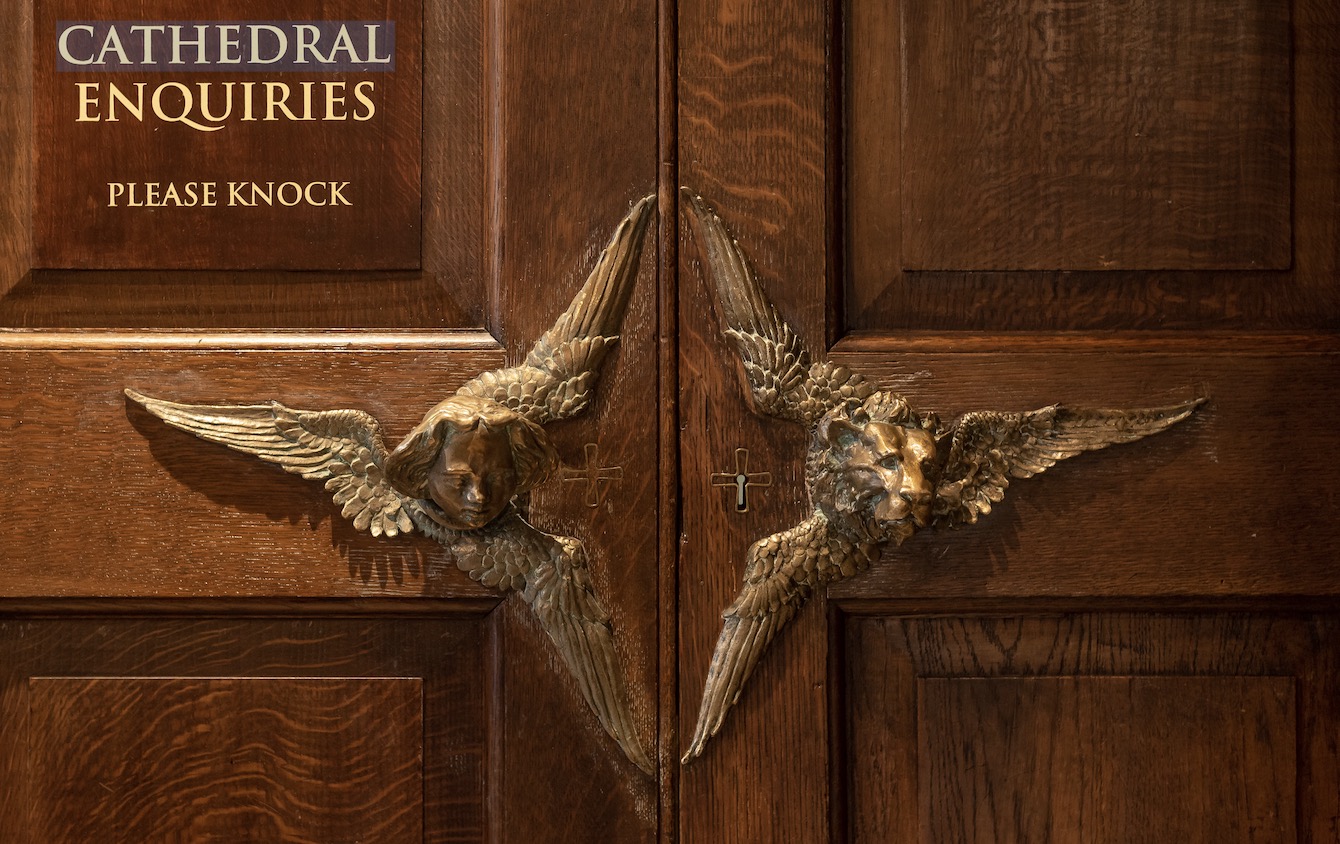
Blackburn Cathedral
The entrance to Blackburn Cathedral features a sculpture in the arched space above the door – known as a Tympanum. Created by Siegried Pietch, a German sculptor working in the UK just before WW2. He was imprisoned here during the war years, but stayed in the UK and developed his work in English churches. The sculpture depicts Jesus as authority over the world. One of the doors also features the shield of The Sacred Heart – denoting that this church is dedicated to Mary, Mother of Jesus.
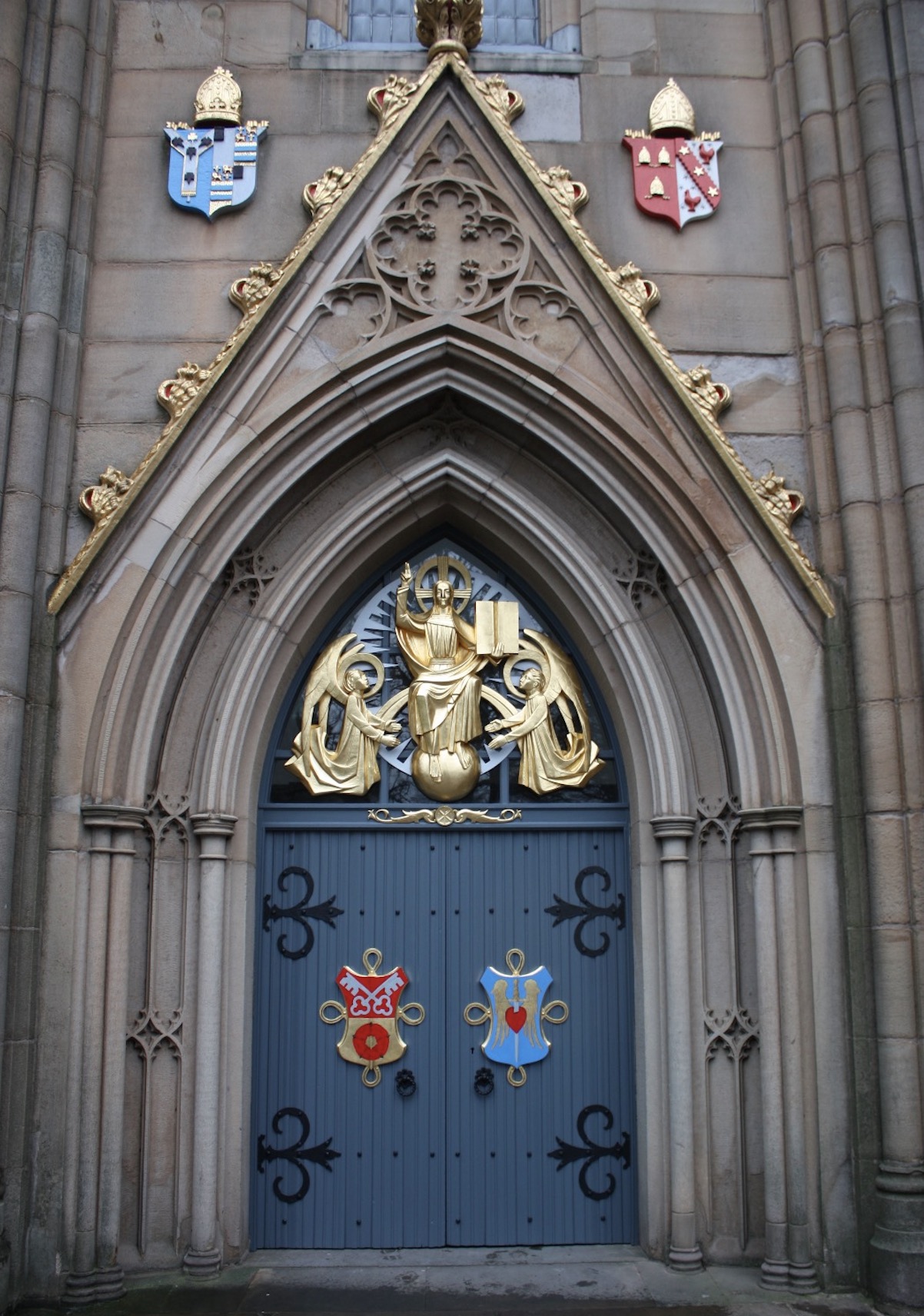
Bradford Cathedral
This doorway to the Song Room dates from 1681 and is the only remaining part of a Bone House built in the 17th century to house remains already buried inside the parish church as was before it was granted cathedral status, to enable more burials inside the church itself. .
The old Bone House was destroyed when the Song Room was built in the 1950s, as it was past repair, but its date-marked doorway was retained, along with the names of two churchwardens of the time – John Greenwood and Josiah Niccoll,
The Song Room is the home of the Bradford Cathedral Music department, where the chorister and adult choir rehearsals take place.
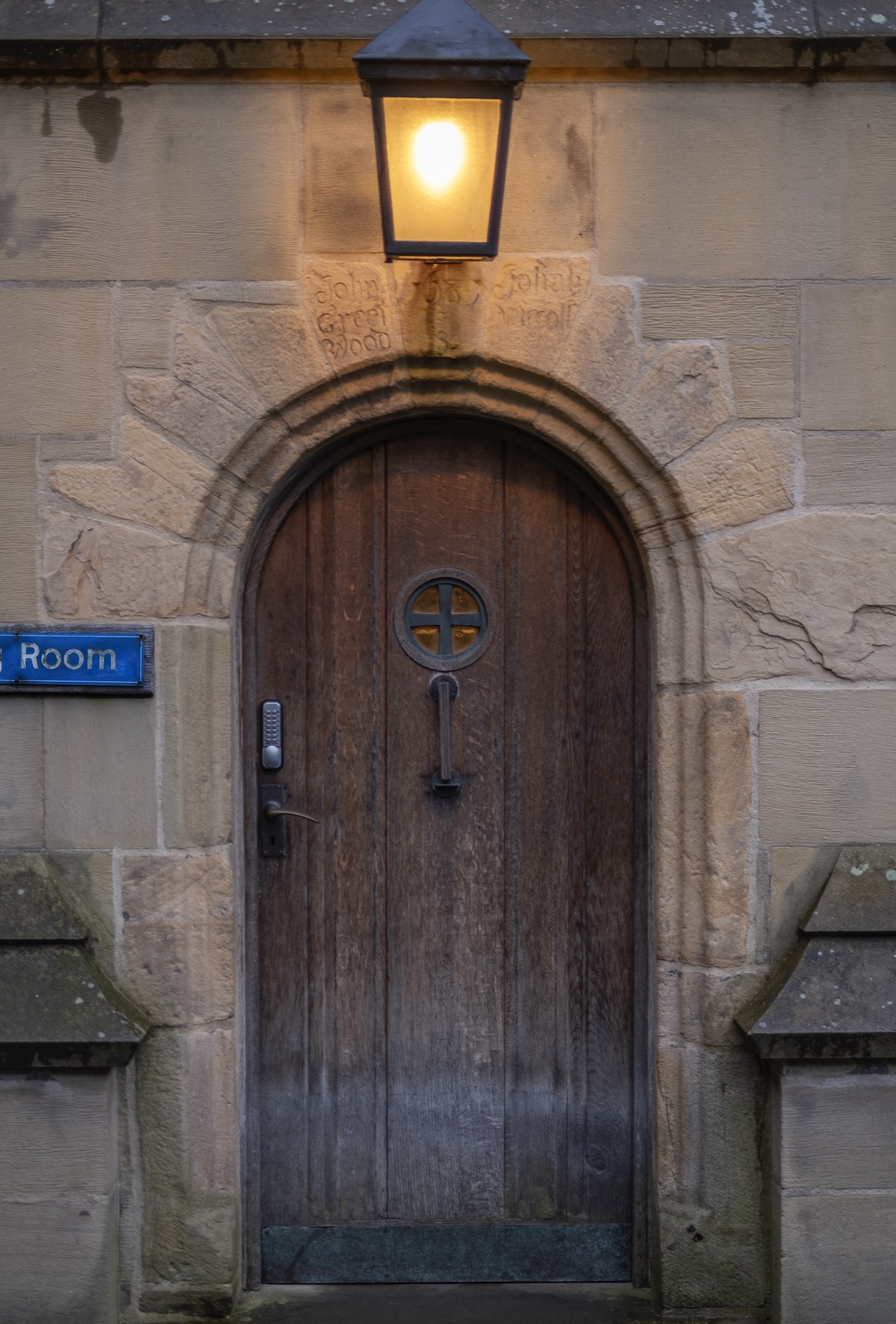
Bristol Cathedral
At the top of the night stairs, leading to what used to be the Abbey dormitory, hangs an old oak door. Despite the embossed dates on the door, in the year 2000 an expert noticed the door’s similarity to a more ancient example from another church, which was dated to 1120-1140. We now know that the Bristol door has hung in the Abbey since its foundation in the mid-12th century, making it one of the oldest doors in the country!
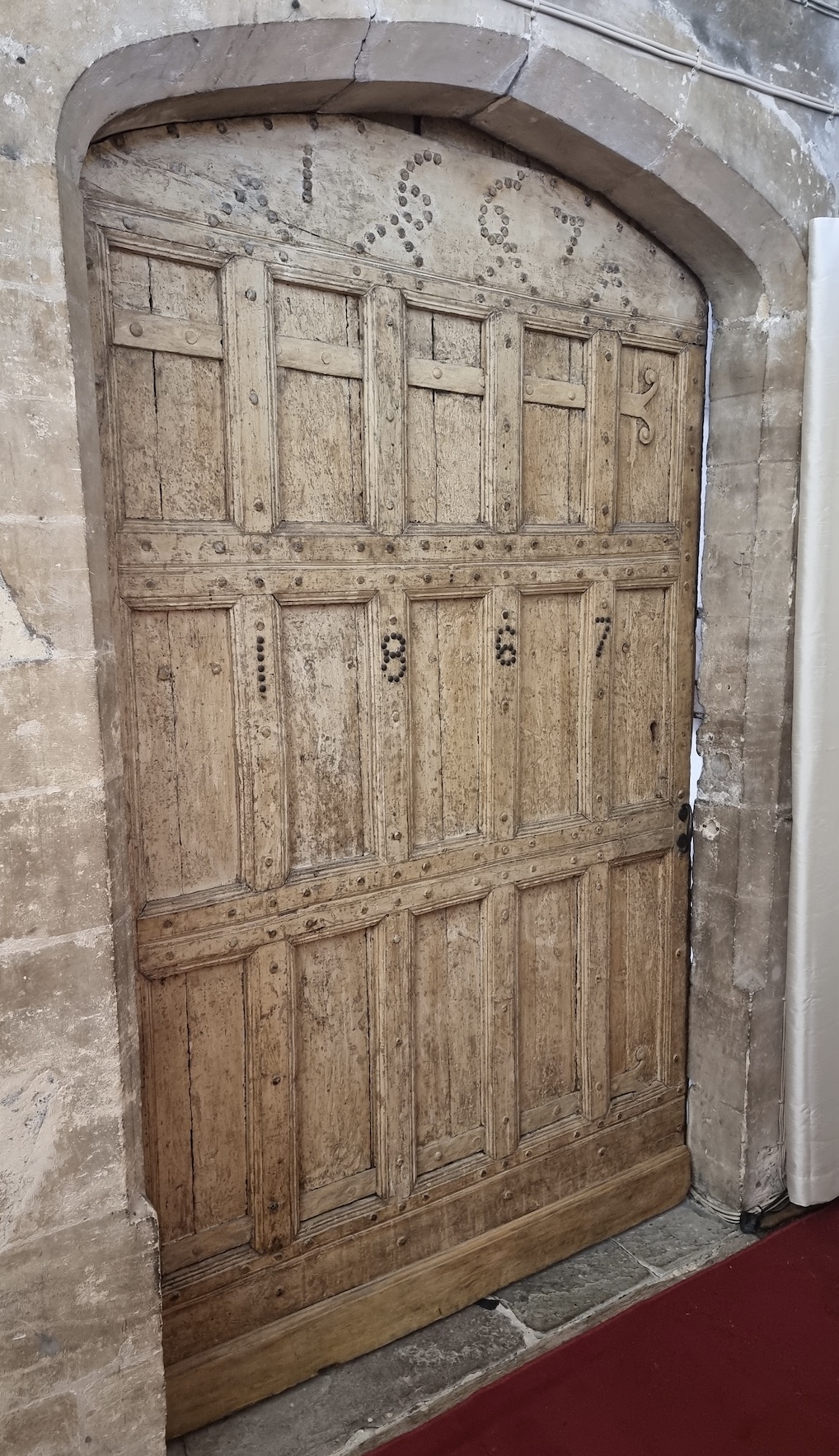
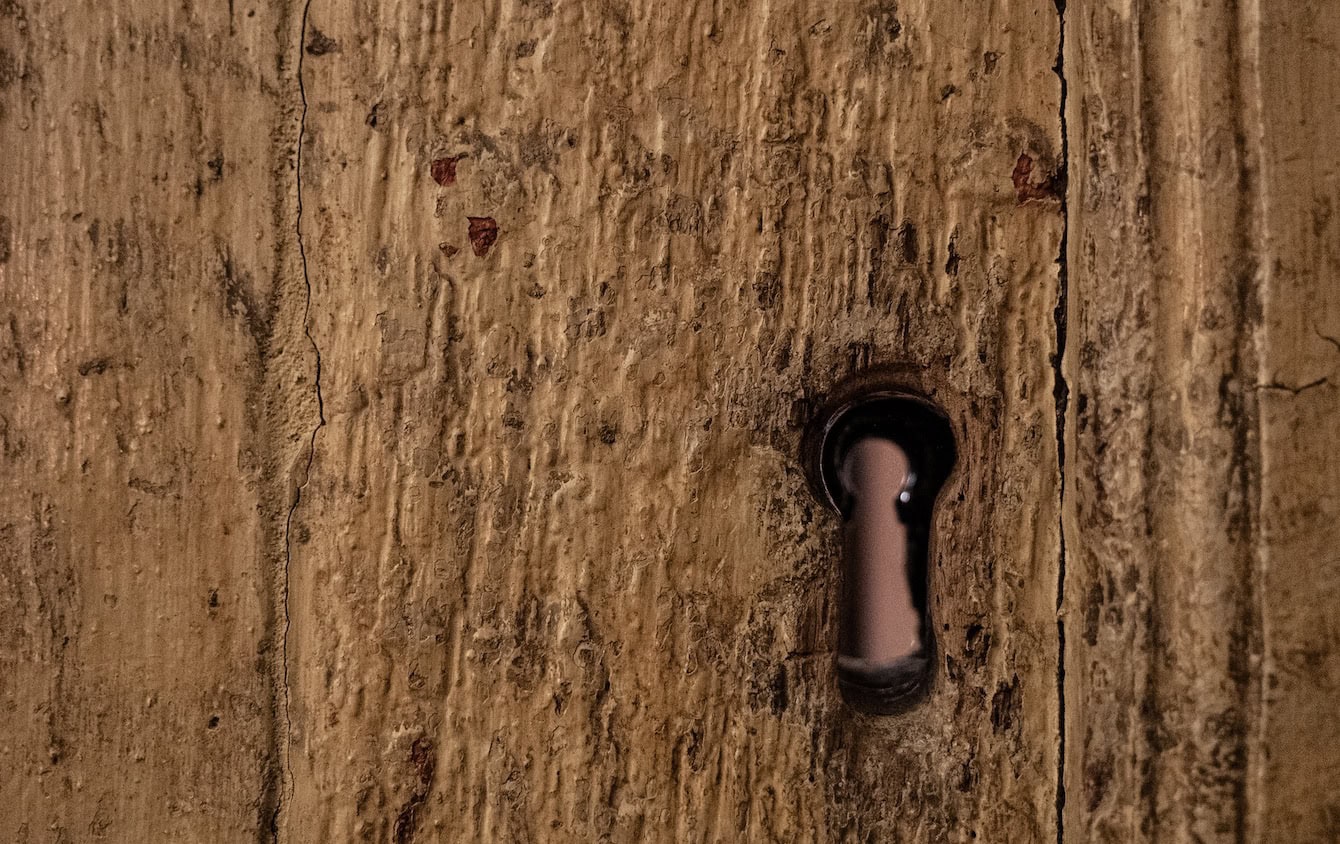
Canterbury Cathedral
The image with the little hatch is a doorway dating from about 1400 leading into the office of the cellarer, who was the monk responsible for food and drink at the monastery. The hatch was for serving ale to monks. The wooden door itself is medieval.
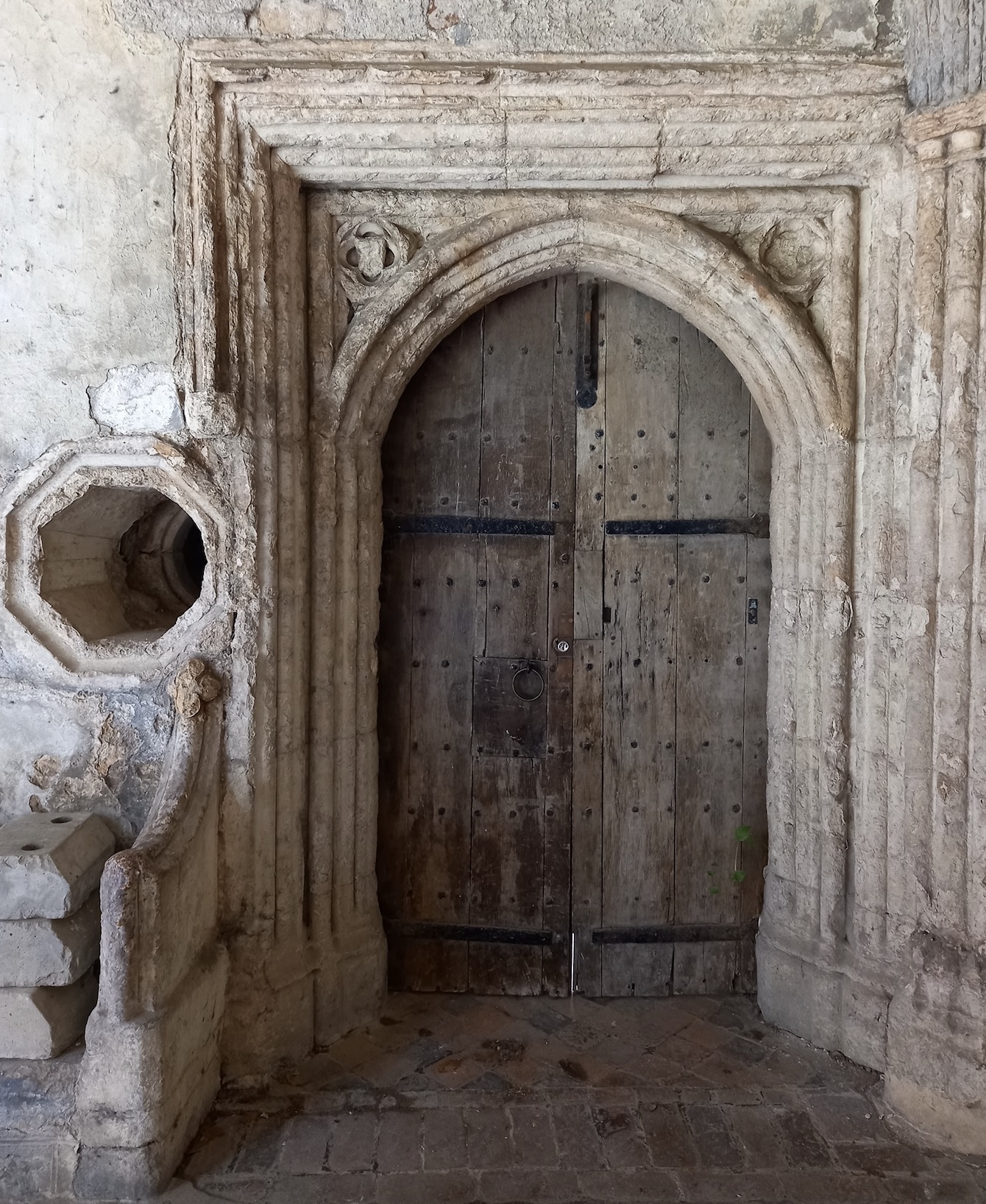
Carlisle Cathedral
Fratry Door. The door to the Fratry was lifted and turned around (including the Stone frame) as part of the Fratry Project, which aimed to bring the medieval building back-to-life, making it a cultural hub in the city centre with the addition of the pavilion café, as well as education, exhibition and event spaces in the Fratry Hall and Undercroft. The project, which took 10 years from conception to completion in 2020, has won a great number of awards including the RIBA North West Award 2022, RIBA North West Project Architect of the Year 2022 and the RIBA National Award 2022.
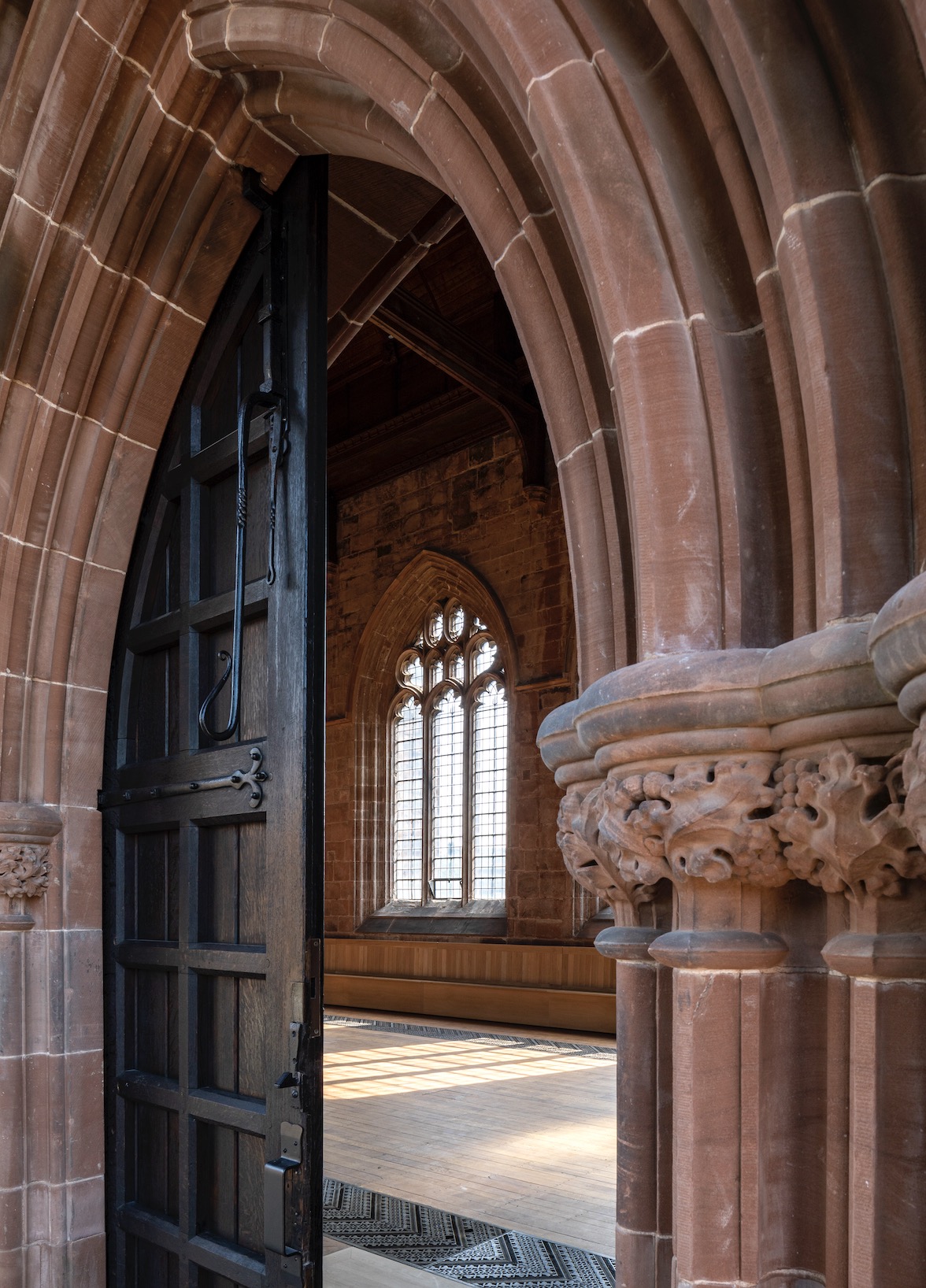
Chelmsford Cathedral
St Cedd’s Chapel is used for daily worship and private prayer and an arched glass screen and doors were commissioned to help shelter the chapel from the business of the main Cathedral building. Daedalian Glass created panels laminated with black voile fabric to create a sense of peace and privacy while maintaining a sense of openness. The glass sits within sculpted bronze gates, the work of Giuseppe Lund who designed the Queen Elizabeth Gate in Hyde Park.
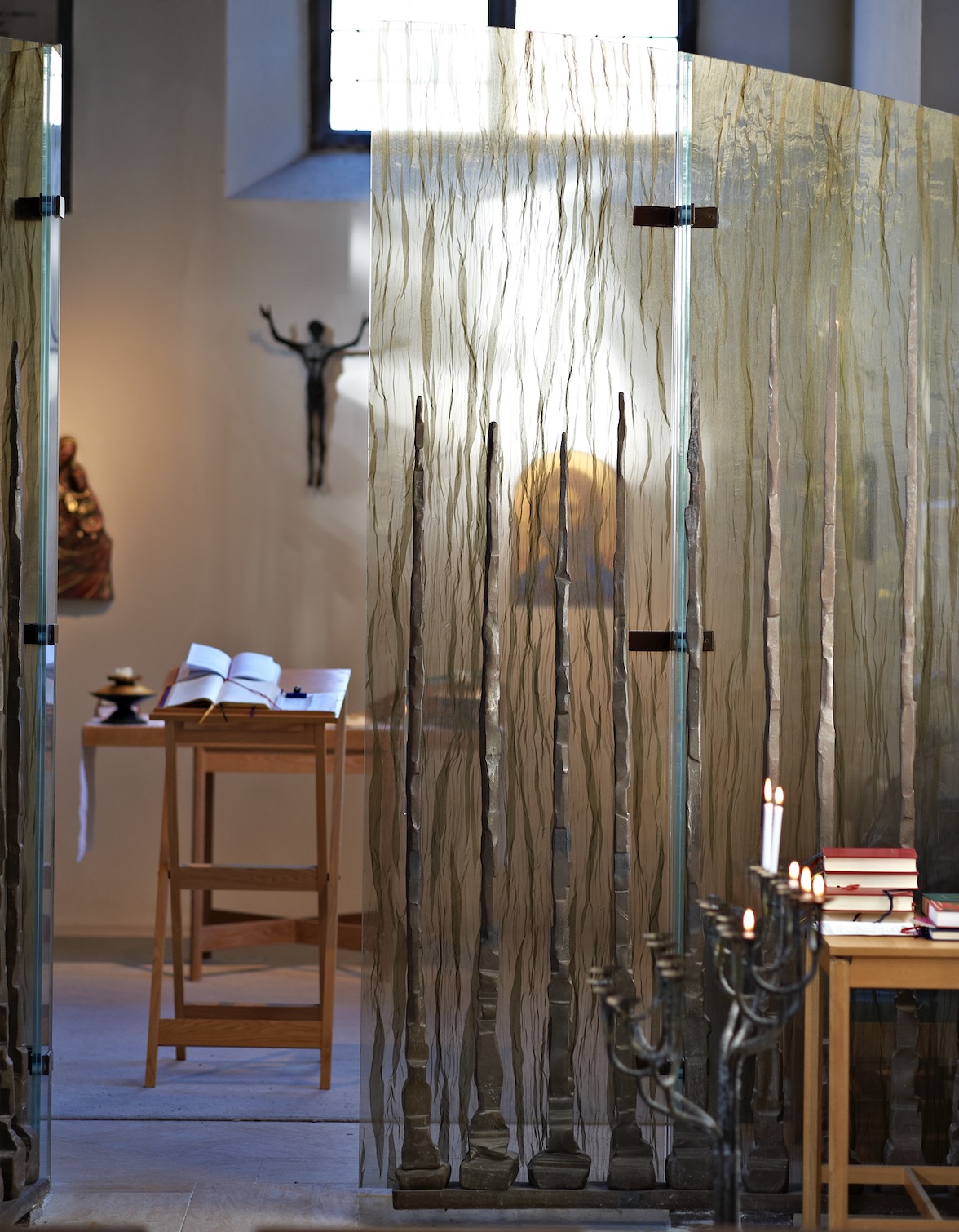
Chester Cathedral
The Pilgrim Porch, installed in 2022 as part of the Queen’s Platinum Jubilee celebrations, allows our medieval wooden doors to remain open to the city, giving a view of the interior of the Cathedral church from the outside: reinforcing the idea that we are an open, welcoming Church. Artist Stephen Broadbent has designed the sculptural bronze porch with ceremonial glass which features, etched in the design of a labyrinth, images significant to churches across the diocese.
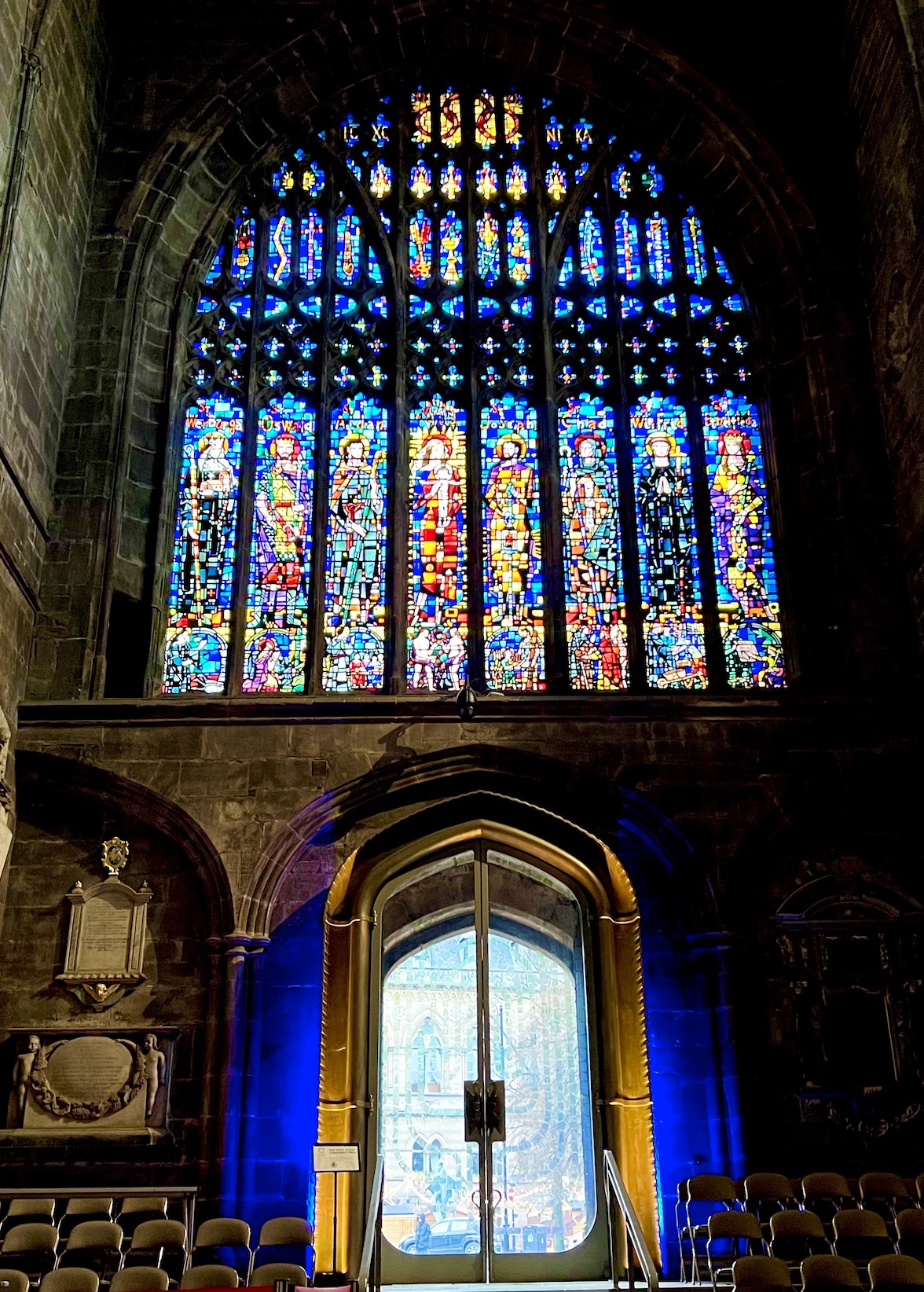
Chichester Cathedral
In the western arm of the Cloisters is St Richard’s porch, this being the door through which Richard de Wych (Bishop of Chichester 1245- 1253) would have entered the Cathedral.
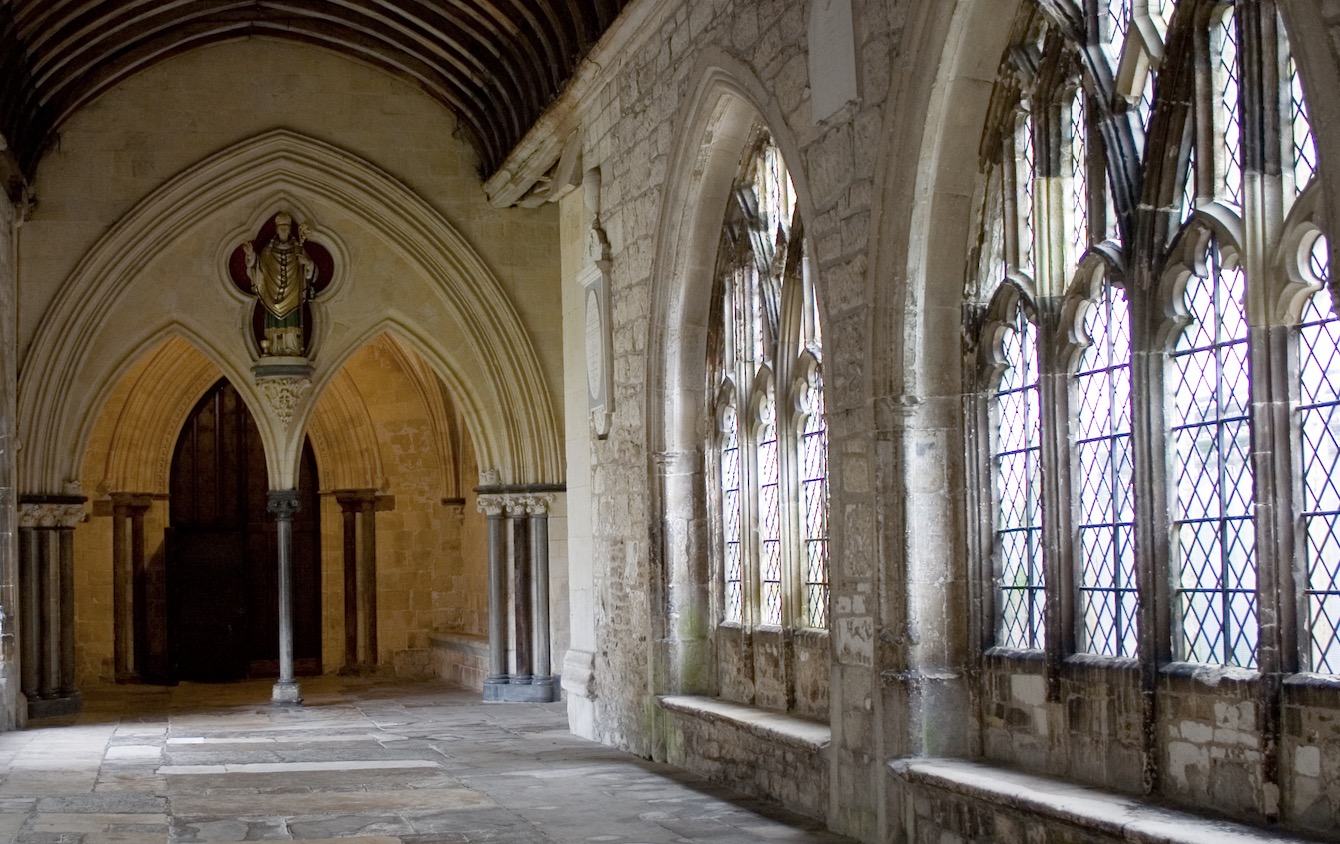
Coventry Cathedral
The mid-13th century South Porch is the earliest surviving part of St. Michael’s Church, also known as Coventry Cathedral.
It would have once been the most important entrance to St. Michael’s before the Coventry Blitz and can be found opposite St. Mary’s Guildhall.
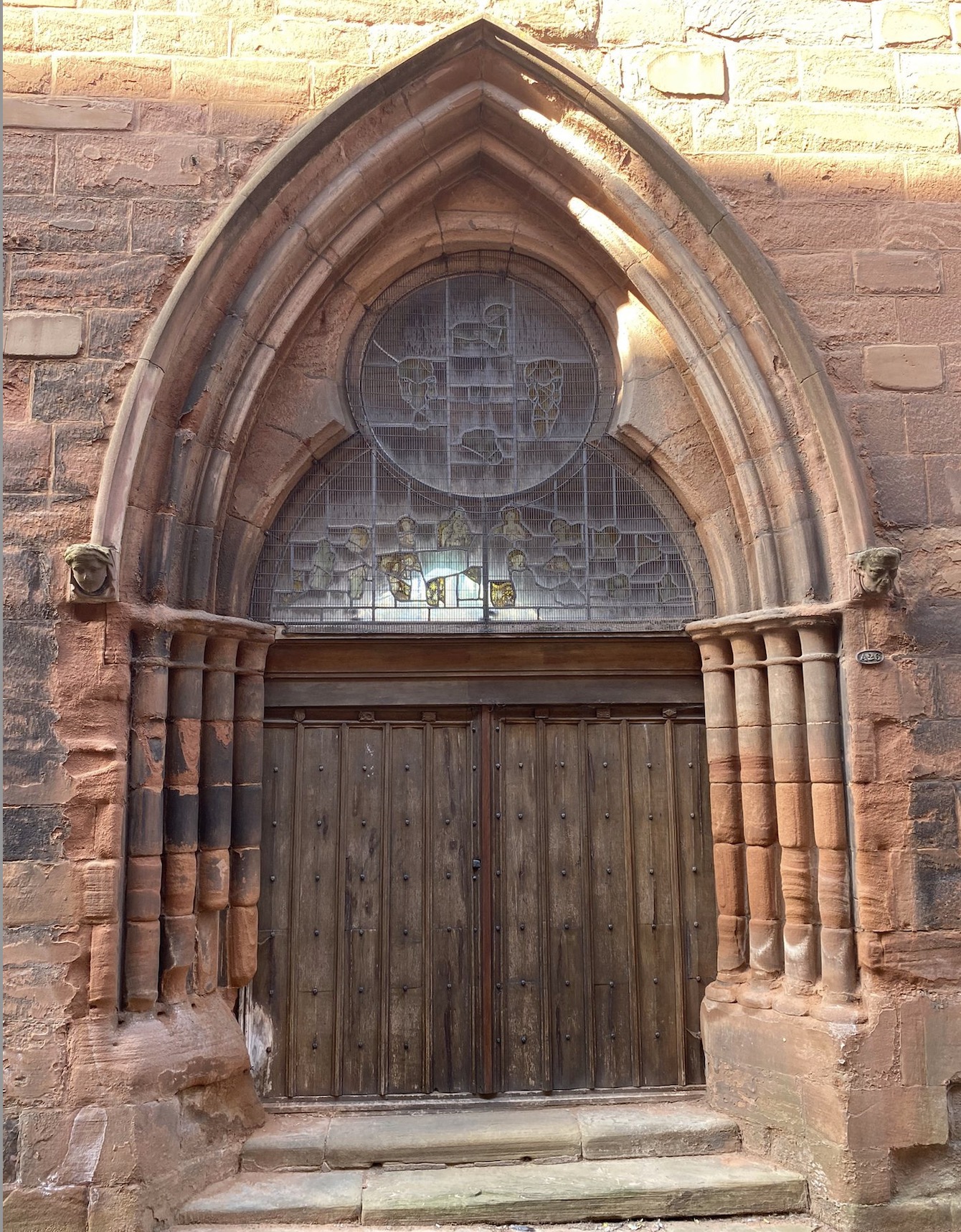
Derby Cathedral
This photograph shows the main entrance doors at the west end of Derby Cathedral. The main doors are guarded by the Cathedral’s impressive entrance gates, made by Robert Bakewell. The gates were moved from St Mary’s Gate in the City in the year 1957. The gates were refurbished in 2012 and renamed Queen Elizabeth II Gates to celebrate the Queen’s Diamond Jubilee.
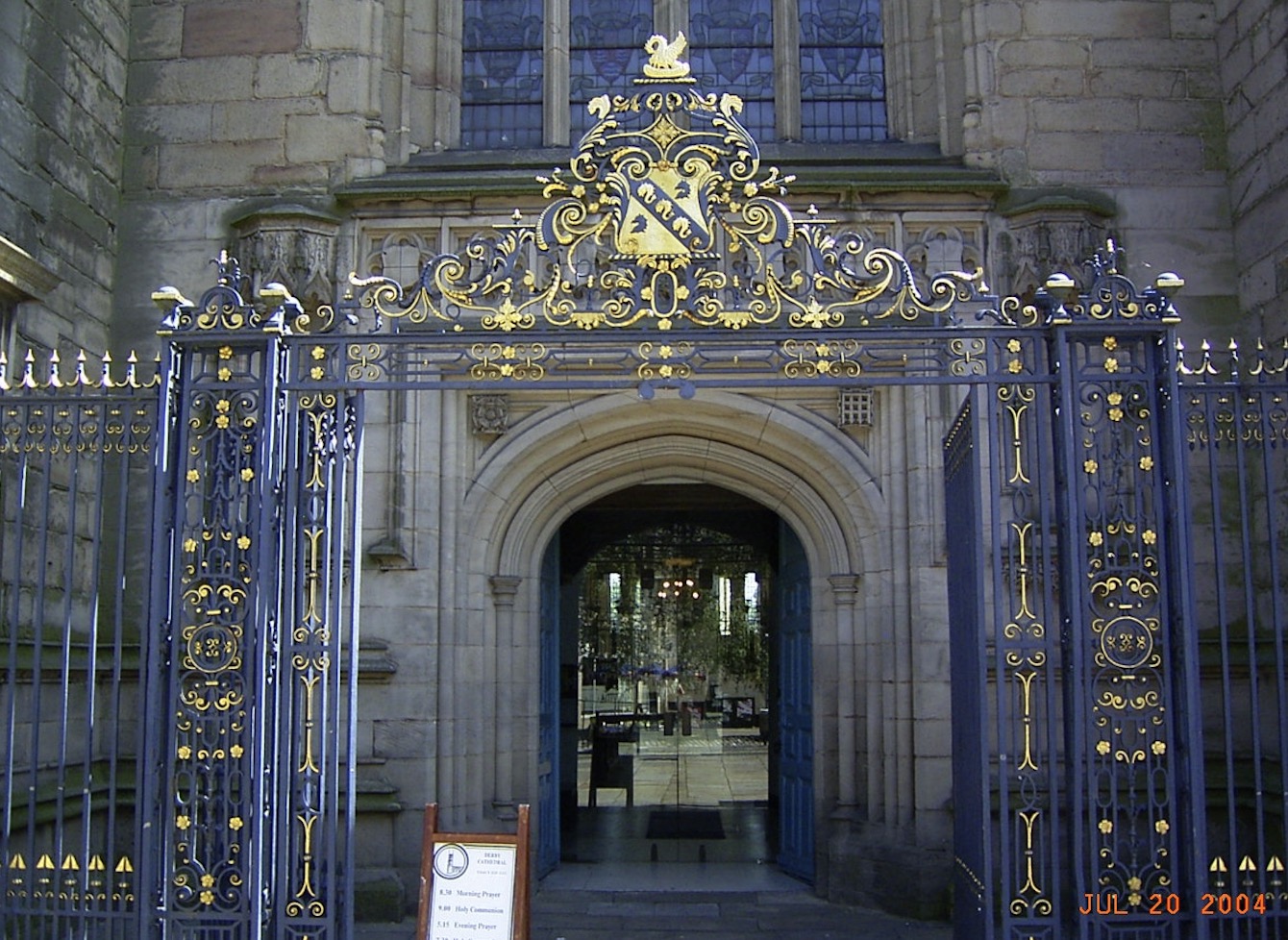
Durham Cathedral
The North Door is one of the historic treasures of Durham Cathedral, dating from the early 12th century. It is made of oak wood, is 3.2 metres wide and 5.6 metres high and recently went under important restoration work.
On the outside of the door is a replica of the Sanctuary Ring. Until 1623, when the right to sanctuary was abolished, people accused of certain crimes could enter the Cathedral by grasping the ring. They were offered a safe place or ‘sanctuary’ for 37 days, after which they either had to face trial or leave the country. The original Sanctuary Ring is now displayed in the Cathedral Museum.
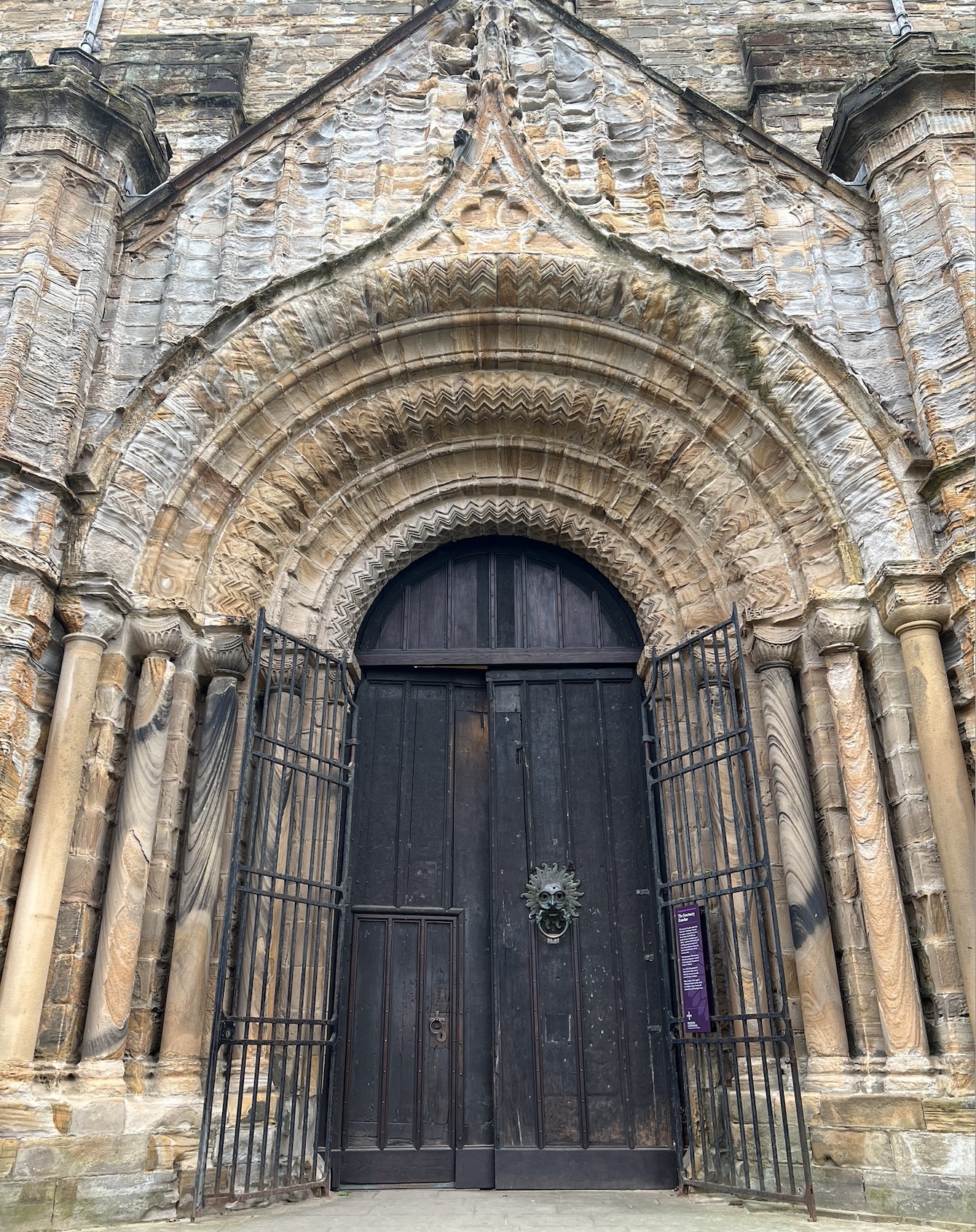
Ely Cathedral
The West doors have a ‘secret’ spyhole to allow the person inside (presumably a monk) to see when to open them and let, perhaps a procession (on Palm Sunday for example) through at the right moment in the liturgy.
The metal figures of birds that are studded onto the surface of the doors are a punning emblem in memoriam of Dean Peacock.
You wouldn’t think it, but the wicket door is relatively recent, there was a rather smaller one, but it was enlarged to the current size only about 50 years ago.
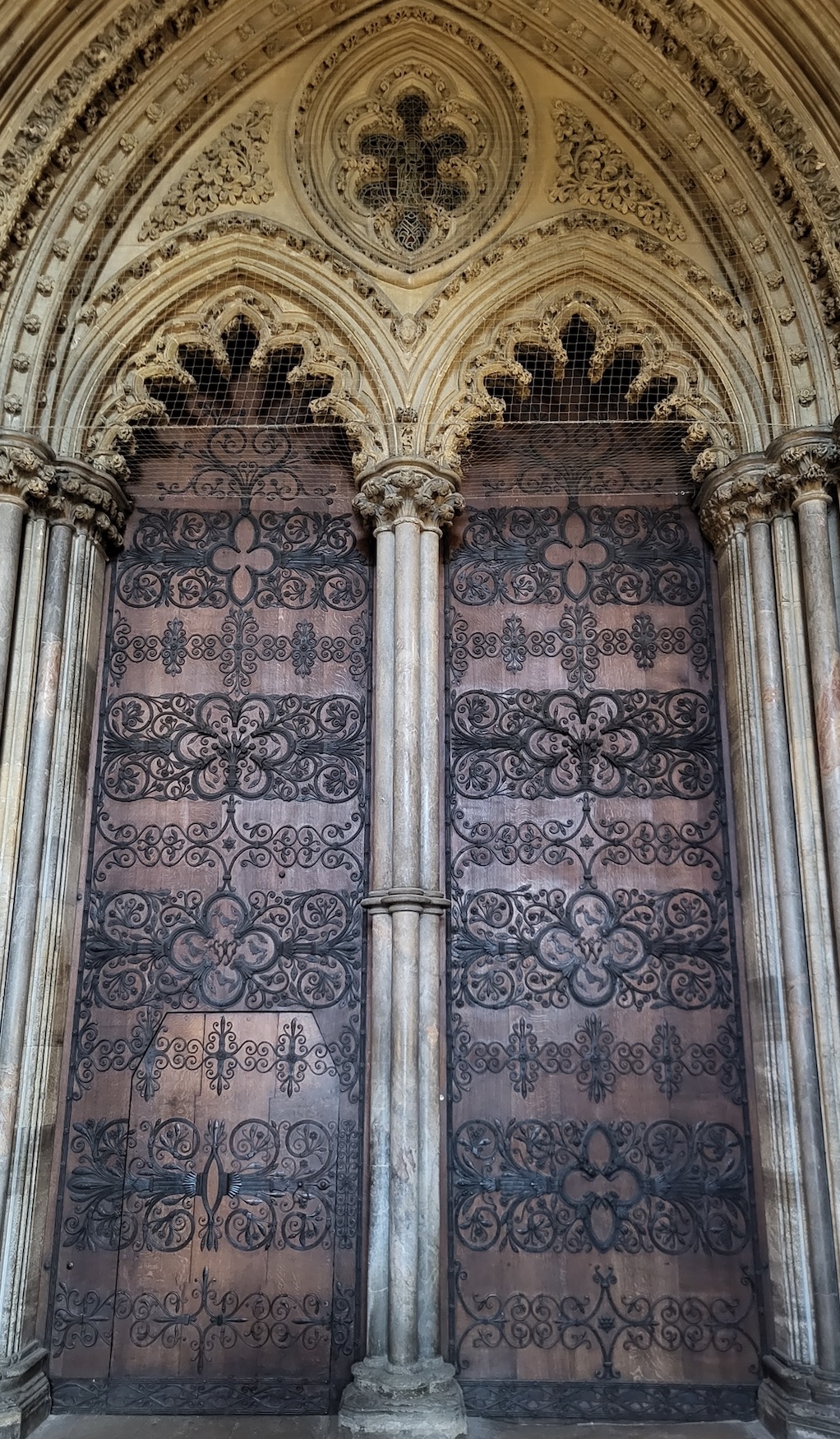
Exeter Cathedral
“Paid ye carpenters 8d for cutting ye hole in ye north transept door for ye Bishop’s cat.”
Of the many doors in Exeter Cathedral, it is a simple small door in the north transept which visitors want to seek out.
The great pair of Romanesque towers now forming the transepts of the cathedral’s decorated Gothic cathedral have massive walls more than two and a half metres thick. In 1376-77 a chamber with a flight of stone stairs was excavated within the thickness of the north wall of the north tower in order to accommodate a clock.
The present clock is one of four medieval astronomical clocks in the south west of England which not only show the time but also represent the state of the moon. The clock face high up in Exeter Cathedral’s north transept fills the round headed opening of a former Romanesque window, with the clock’s driving mechanism in the space within the wall.
For centuries, it was common practice for cats to be used to keep places free of pests and Exeter Cathedral’s records include quarterly payments of 13d (one penny per week) for “the cat” during the fourteenth and fifteenth centuries. There was a brief period when this was doubled which may indicate that sometimes two cats were on the payroll.
The employment of a cat appears to have ceased by the time William Cotton became bishop in 1598. When Bishop Cotton arrived in Exeter he found both the cathedral and his palace in a poor state of repair, and it is from Bishop Cotton’s time that the cathedral records contain the entry “Paid ye carpenters 8d for cutting ye hole in ye north transept door for ye Bishop’s cat.”
It is this cat hole, cut in the door below the clock face more than 400 years ago, which can still be seen today. Animal fat was used to lubricate the clock mechanism which would have been a great attraction for vermin. Hence the need for the cat to have access to this space in the north wall. It is not known whether Bishop Cotton’s cat received any payment for its services.
The association of mice with clocks has long been immortalised in the nursery rhyme Hickory, Dickory, Dock often illustrated with a picture of a mouse climbing the outside of a longcase clock. However, the origins are much more likely to date back to clocks lubricated with animal fat and where mice would probably run up the long weight lines regulating the clock mechanism. However, there is no evidence of the nursery rhyme originating in Exeter Cathedral.
Fortunately, today Exeter Cathedral has no need for the services of a feline ‘mouser’. Sometimes a resident cat from homes in the Close may venture into the building and occasionally a cat has been persuaded to pose in the famous door. However, the cats most likely to be seen by visitors to Exeter Cathedral are those carved in stone or perhaps a model cat placed in the cat hole to entertain children and adults alike.
Thanks to Diane Walker for this.
Image Credit: Peter Smith Newbery Smith Photography
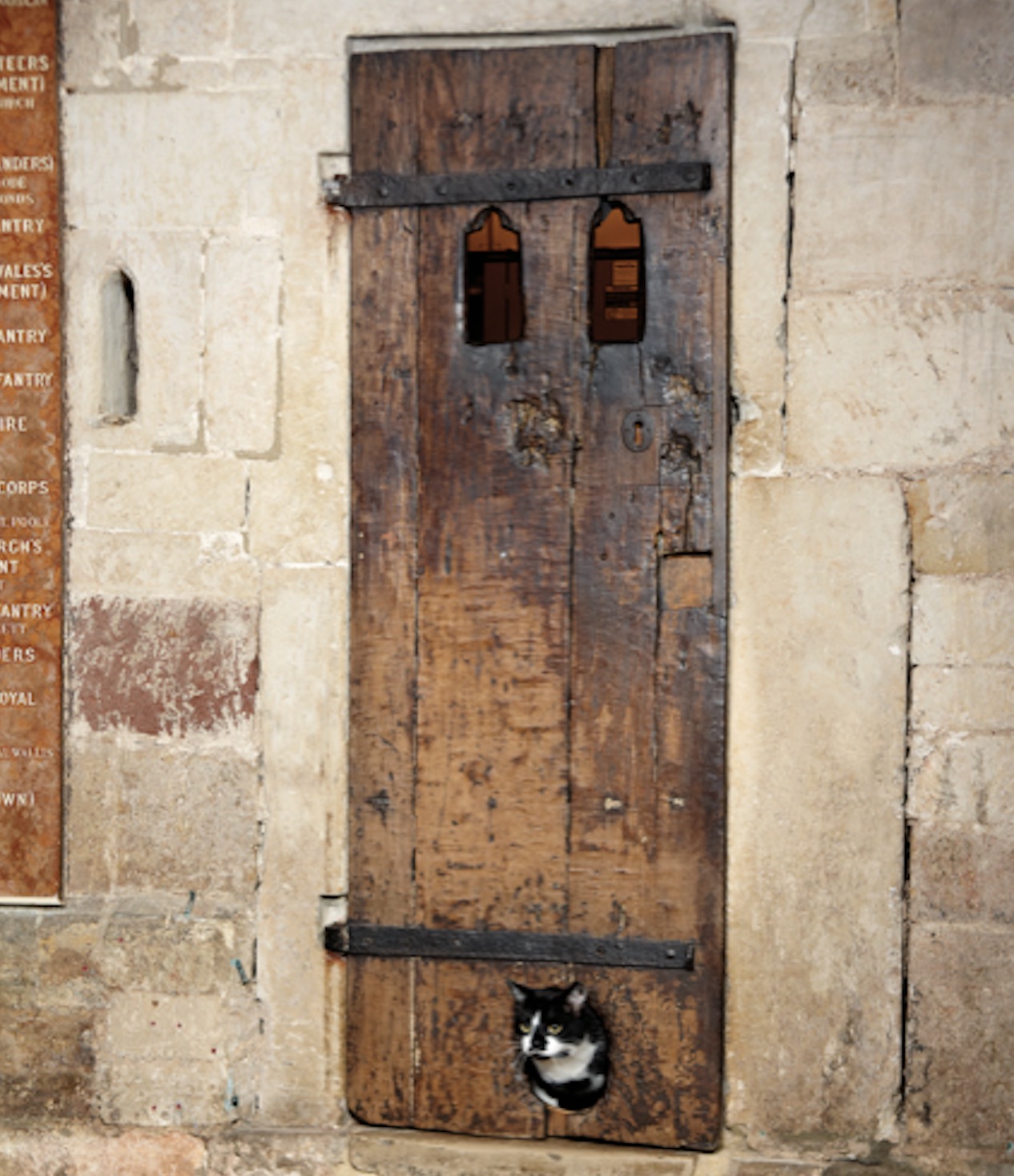
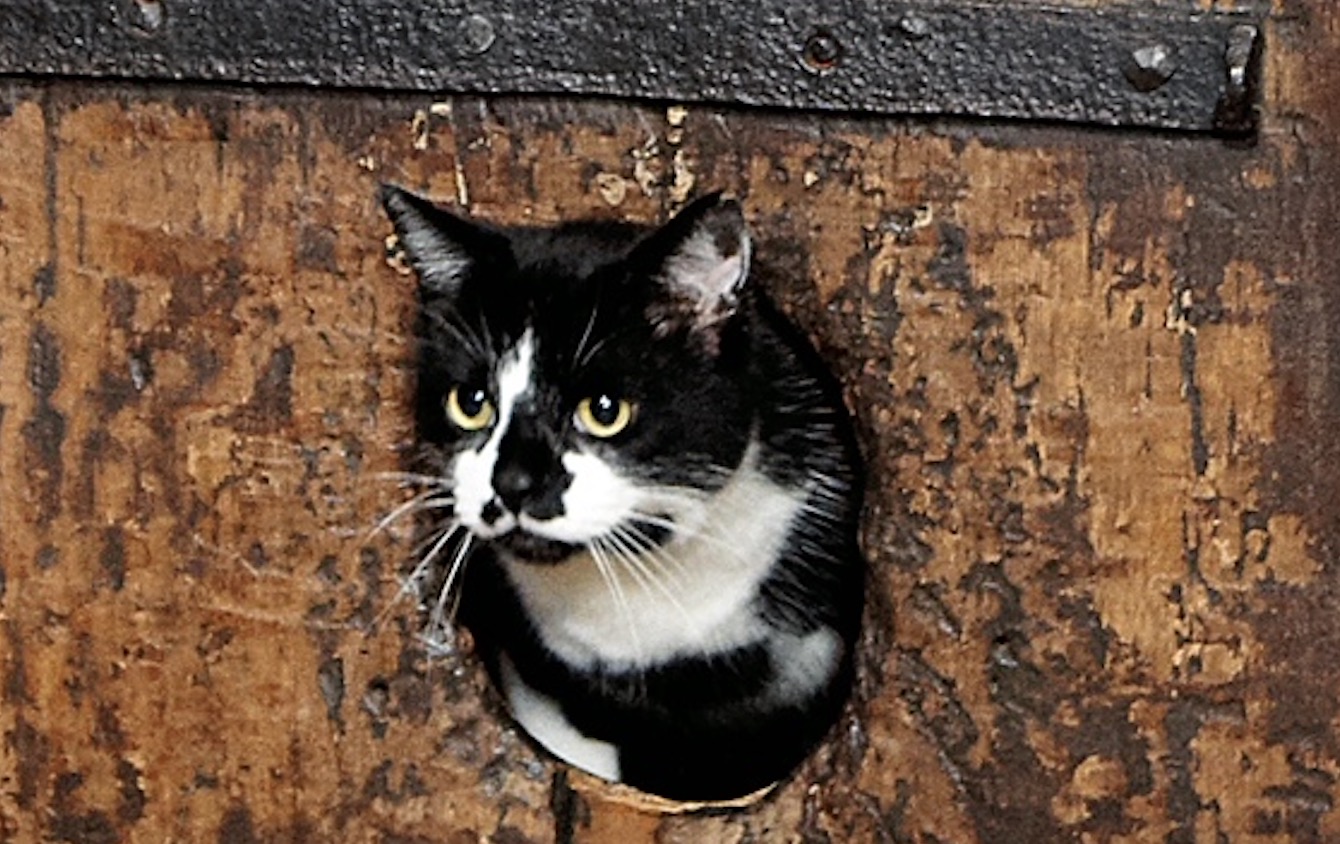
Gloucester Cathedral
Little is known about this hatch-like door, which is located to the West (right) of the Lavatorium in the North Walk. One theory suggests that the hatch was connected to the water supply which served the adjacent washroom; another theory suggests it housed a bell used to call the monks at mealtimes.
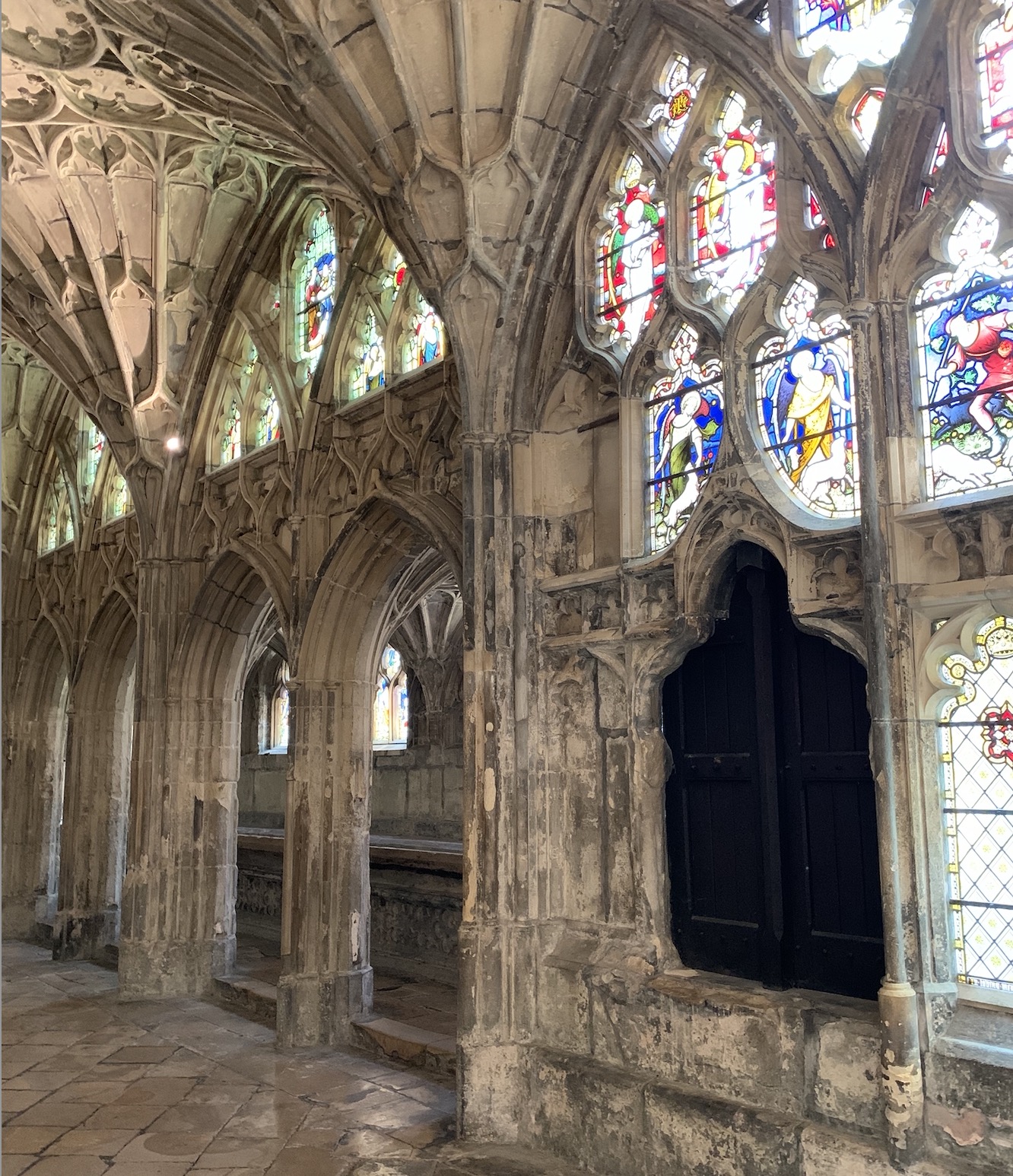
Guildford Cathedral
St Ursula’s Porch. The entrance to the South East side of Guildford Cathedral is via St Ursula’s Porch. St. Ursula is the Patron Saint of the Ursuline Order of Nuns, who founded schools for the education of girls and women throughout Europe. She is also the Patron Saint of Catholic education, of students and teachers, and of the University of Paris.
The doors to this entrance were made at Bromsgrove, each weigh approximately half a ton. The handholds are formed as bishop’s staffs or crooks and indicate that this entrance is primarily regarded as the Bishop’s Entrance.
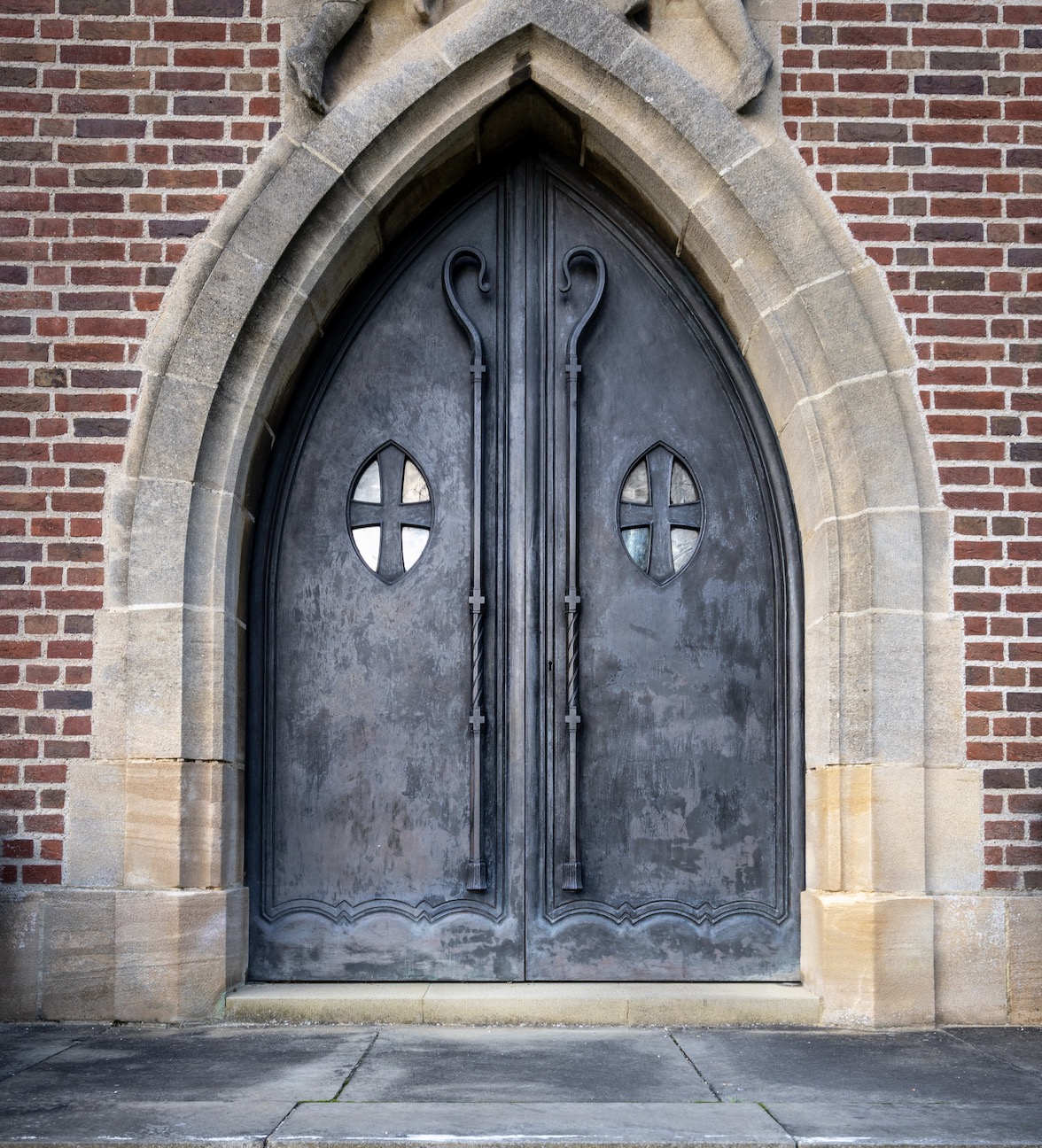
Hereford Cathedral
Door to the Cloisters. This door is a door within a door and has moved position twice in its life here at Hereford Cathedral.
It dates from 1472-5 and originally the original door into the College Cloisters opening out directly onto Cathedral Close. It features a Wickett gate, which is a pedestrian gate built within a door.
It has lots of nails! Set in 26 rows horizontally and 19 columns vertically, and is mounted on three large iron hinges.
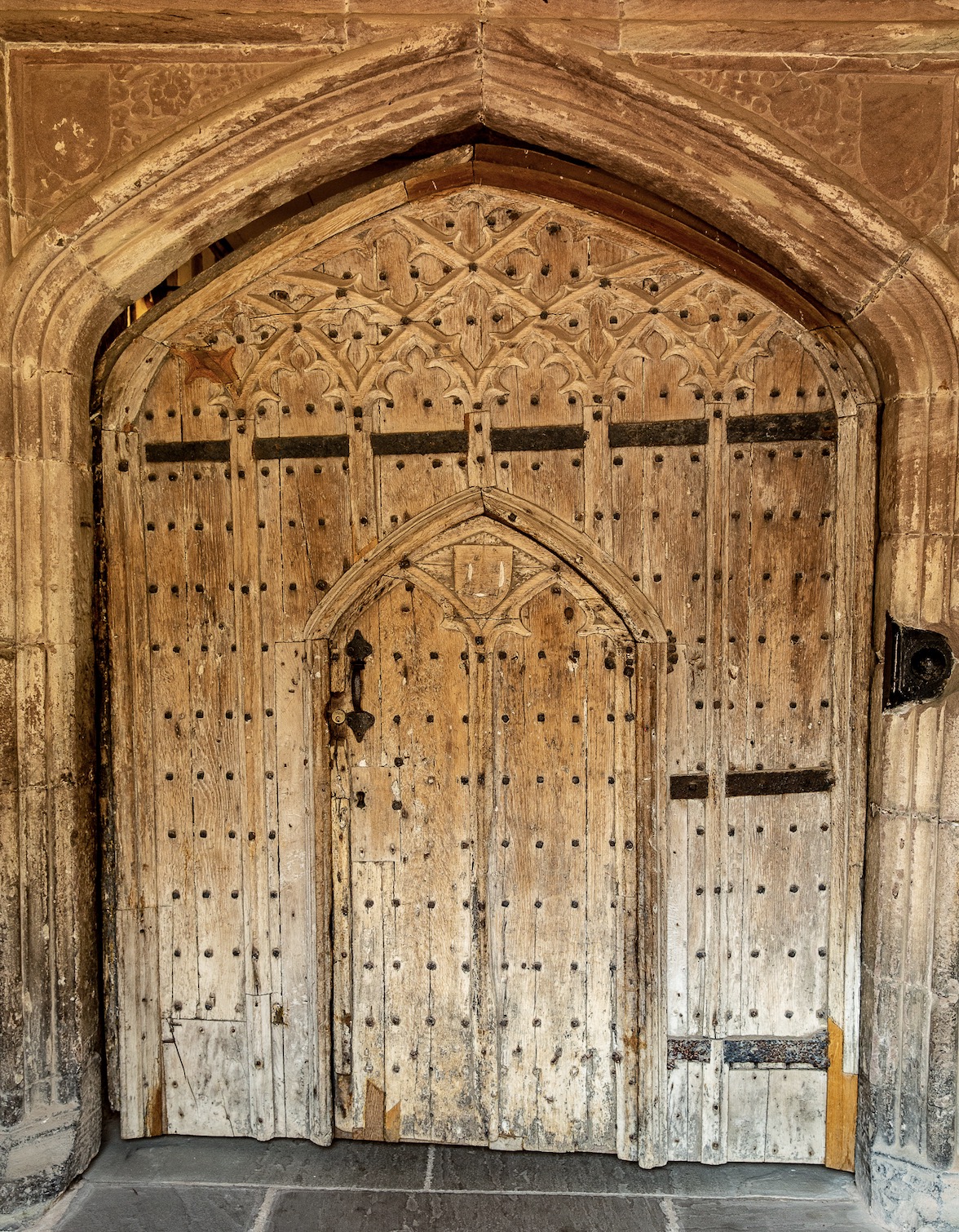
Stained Glass window door. This secret door is built within one of the stained glass windows next to the muniments room here at Hereford Cathedral.
One of six windows in the choir clerestory, the three on the north side have geometric patterns. Two on the south side originally also had geometric patterns, but these were replaced with clear glass in 1930.
Those on the north installed c1845 as part of the cathedral restoration, made by Castell of Whitechapel.
The door leads from a walkway above the choir out onto the roof .
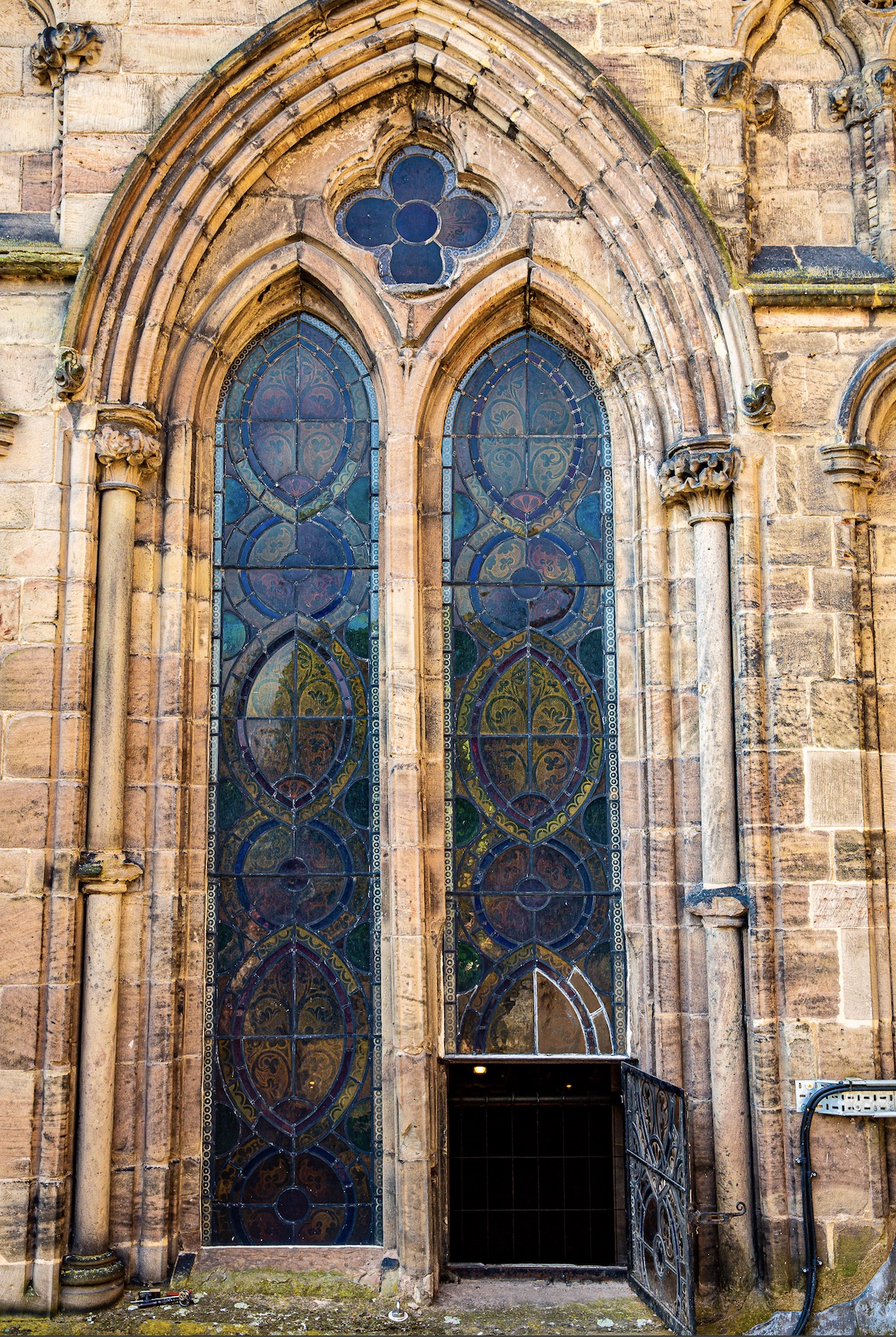
Leicester Cathedral
Work being finished on the North Porch in advance of Leicester Cathedral’s reopening on Advent Sunday this year. This door will be the entrance to Cathedral until the completion of the new Heritage and Learning Centre in Summer 2024. We can’t wait to welcome people back through it for the first time since we closed for renovations in January 2022.
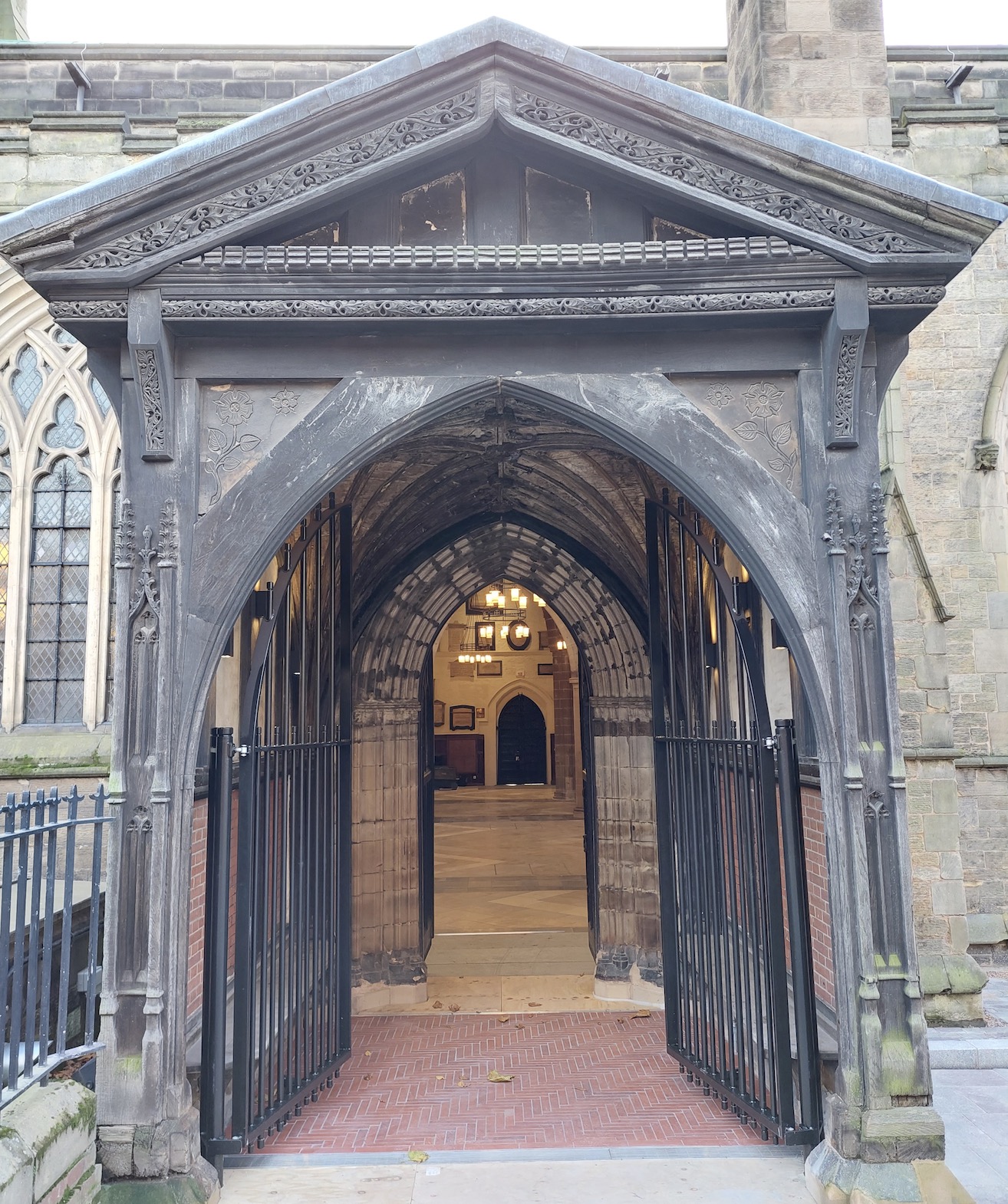
Lichfield Cathedral
The great West Door of Lichfield Cathedral are beautifully ornate. The scrolling ironwork was produced in the 13th century by the same man who created the ironwork for the Eleanor crosses (the most famous of these being Charing Cross). Edward I commissioned these crosses as a memorial to his wife, they were put up to show where his wife’s coffin had rested on its way to Westminster.
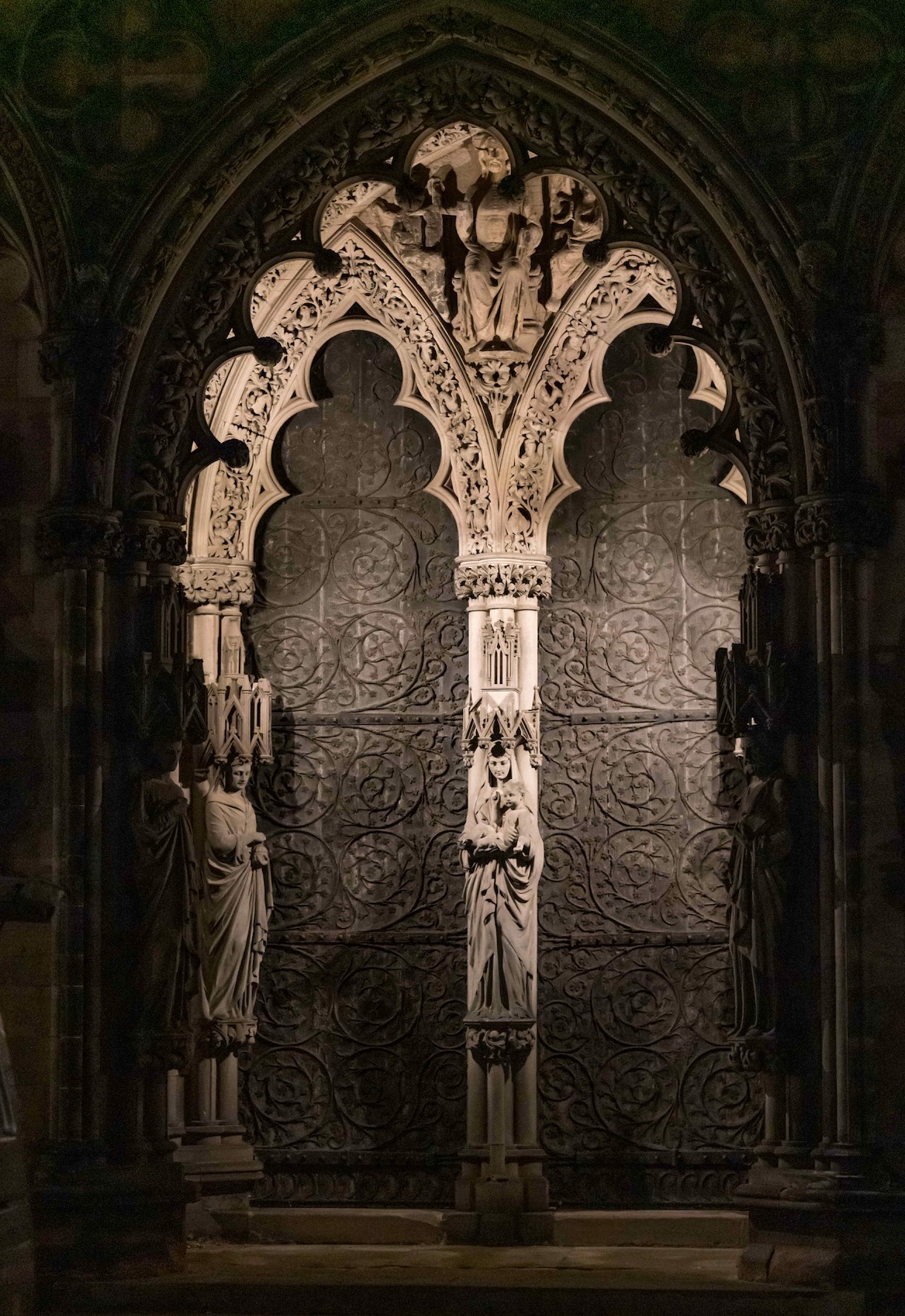
Limerick – St Mary’s Cathedral
According to tradition, Domnall Mór Ua Briain, the last King of Munster, gifted his palace to the Church in 1168 thereby creating Saint Mary’s Cathedral, Limerick.
It is understood that the only part of the palace to survive is the doorway, thus making it the city’s oldest doorway still in use!
See more on the St Mary’s Cathedral website here.
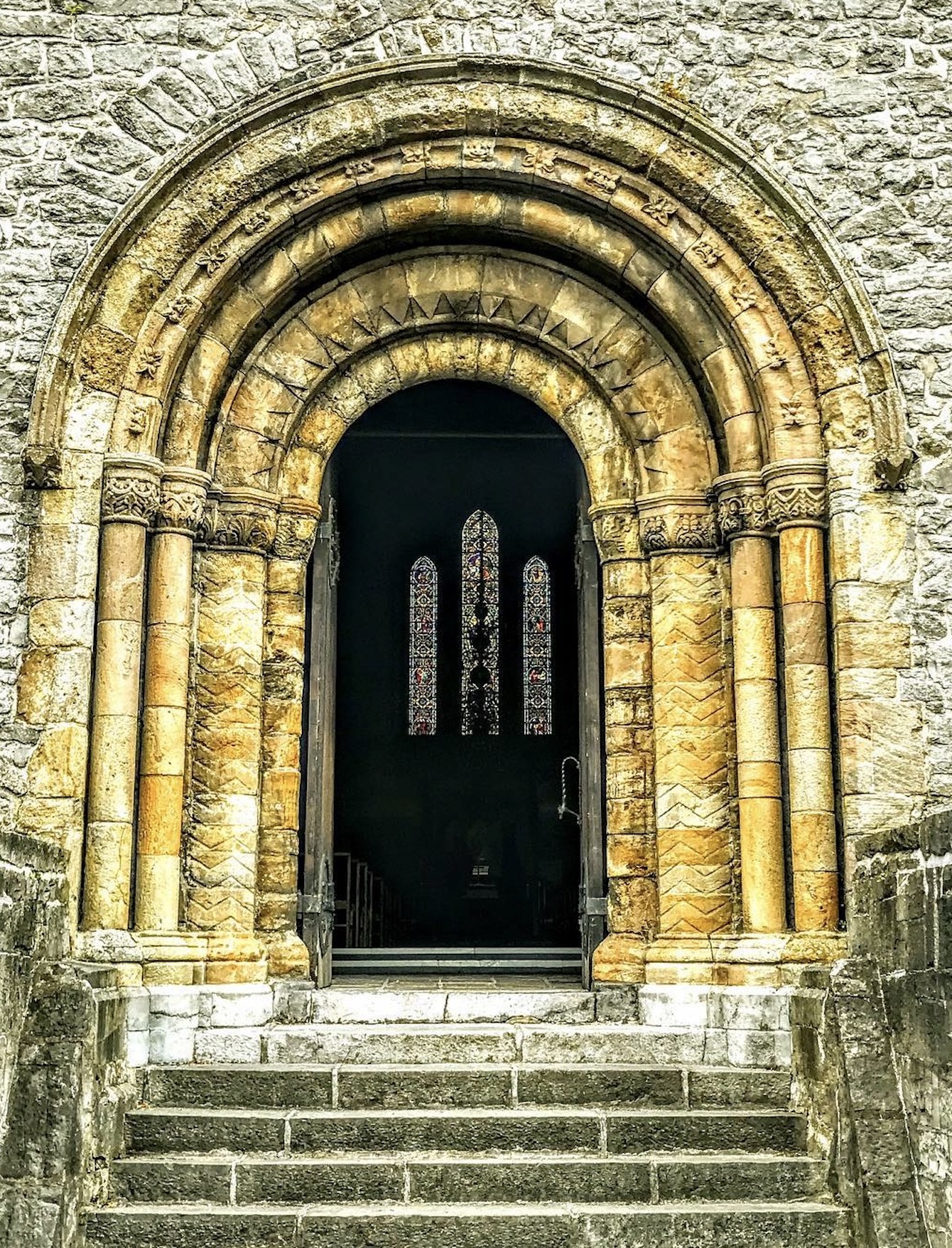
Lincoln Cathedral
Central Tower Trap door. The trap door in the Bell Tower (top right of this image) had to be made wider when Great Tom – the Cathedral’s big bell – was recast at Whitechapel in November 1834. It took a team of 8 horses 7 days to arrive at Lincoln with the new bell in April 1834.
Great Tom then had to be hoisted up 165 feet through the central tower to the Bell Chamber. It took a team of 50 workmen and bell ringers 2 hours 44 minutes to do this and the opening in the floor of the clock chamber had to be widened by removing part of the vaulting. Even then, it was a tight fit. So, to avoid damaging the new bell, they tied two small boys onto the bell so that they could guide it through the opening! The bell weighs five tons and 8 hundredweight (in old money) or 5.49 metric tonnes.
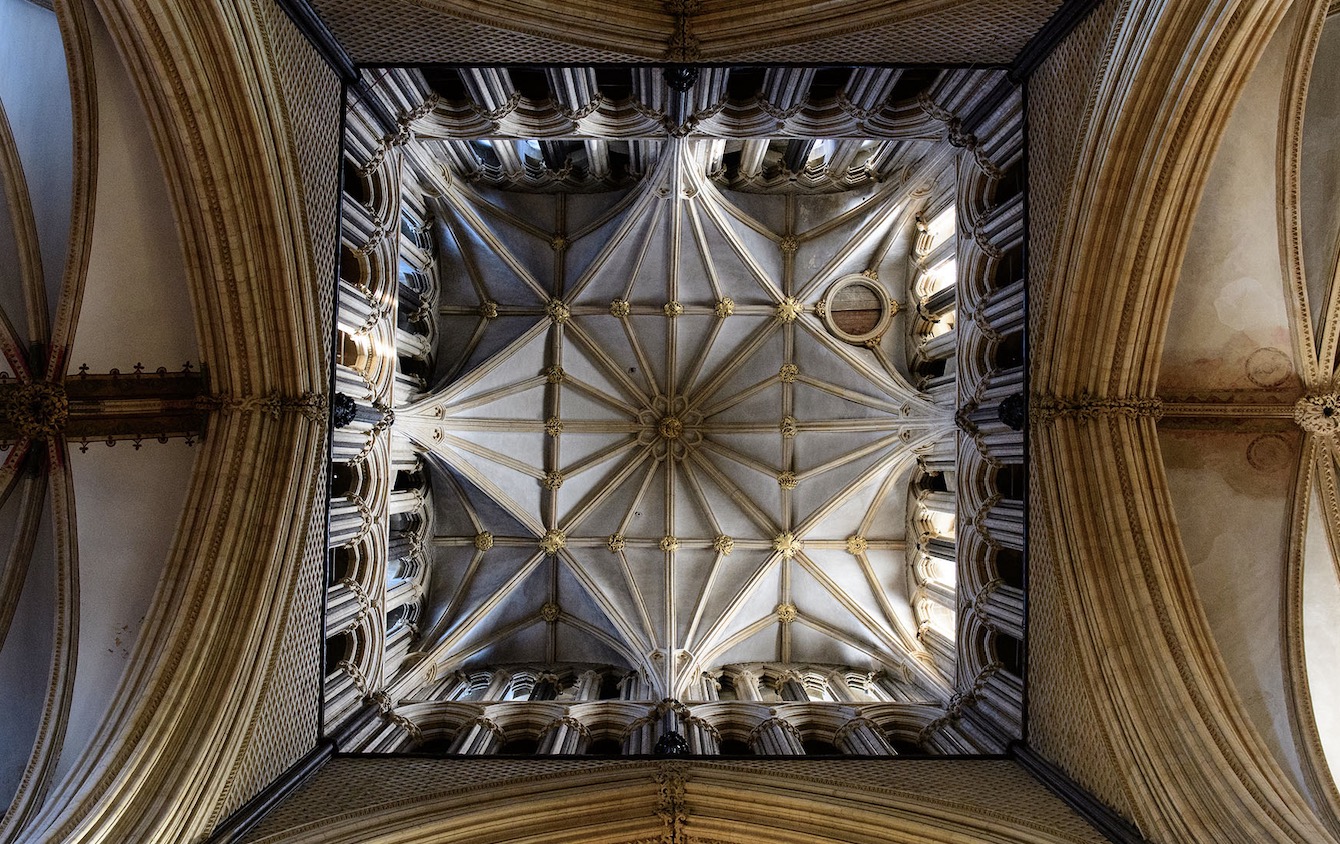
Liverpool Cathedral
The Great West doors at Liverpool are English oak and each weigh over a ton. They were designed by the Cathedral Architect Fredrick G Thomas and fitted in 1981 which was too late for the Queen’s visit to consecrate the Cathedral in 1978 and therefore the Choir were banked up to cover the fact!
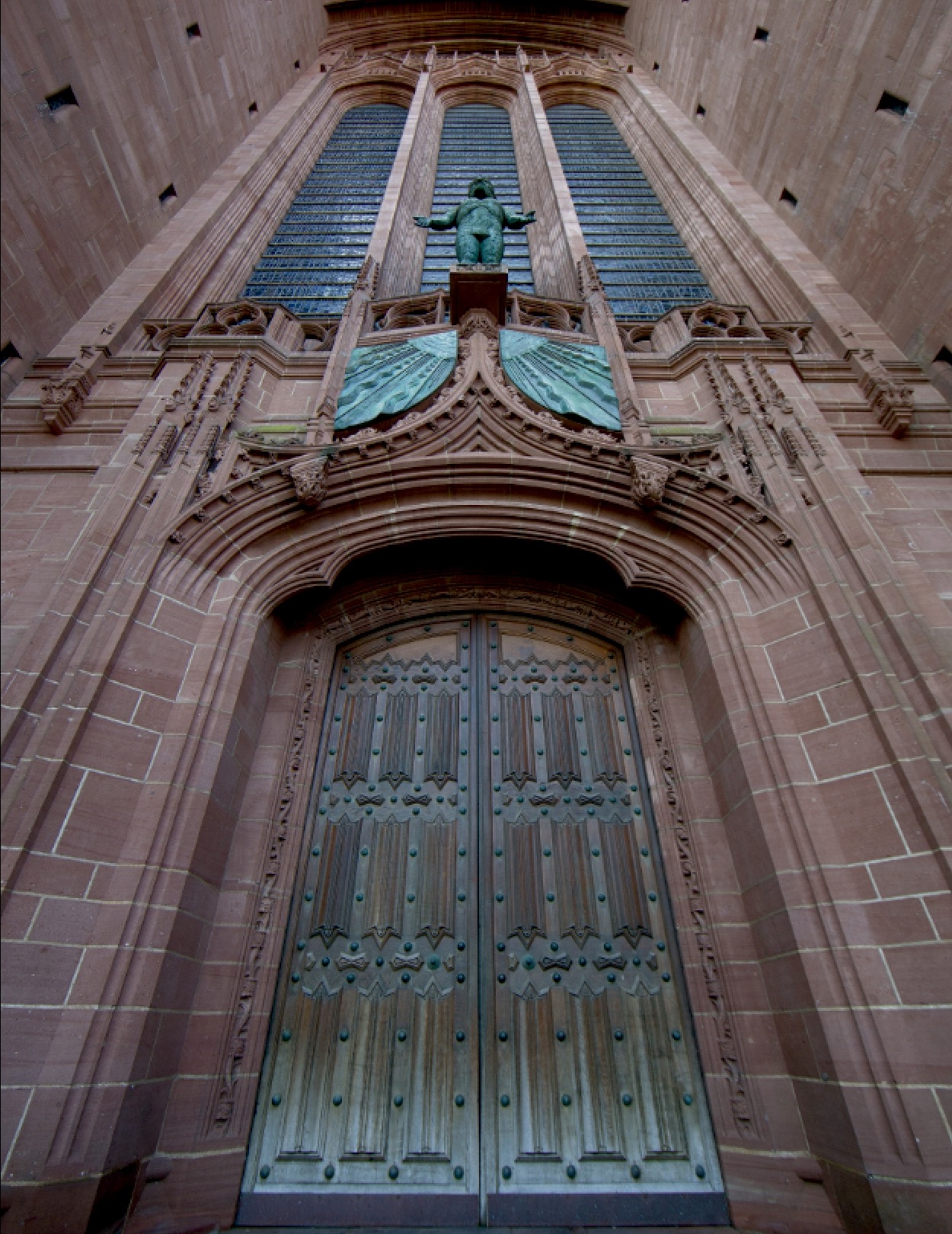
Manchester Cathedral
Manchester Cathedral’s north doors are surrounded by a beautiful archway of stone carvings depicting instruments of the Passion, including the tomb, crown of thorns, coins, and a central stone of Christ in Majesty.
This ornate entrance was originally used by the Barons and clergy as it was close to their residence, now Chetham’s School of Music, while the south entrance was used by the townsfolk.
The north porch also includes carved angels holding shields with symbols of St George, St Denys and St Mary, to whom the church is dedicated, and the Lancashire rose.
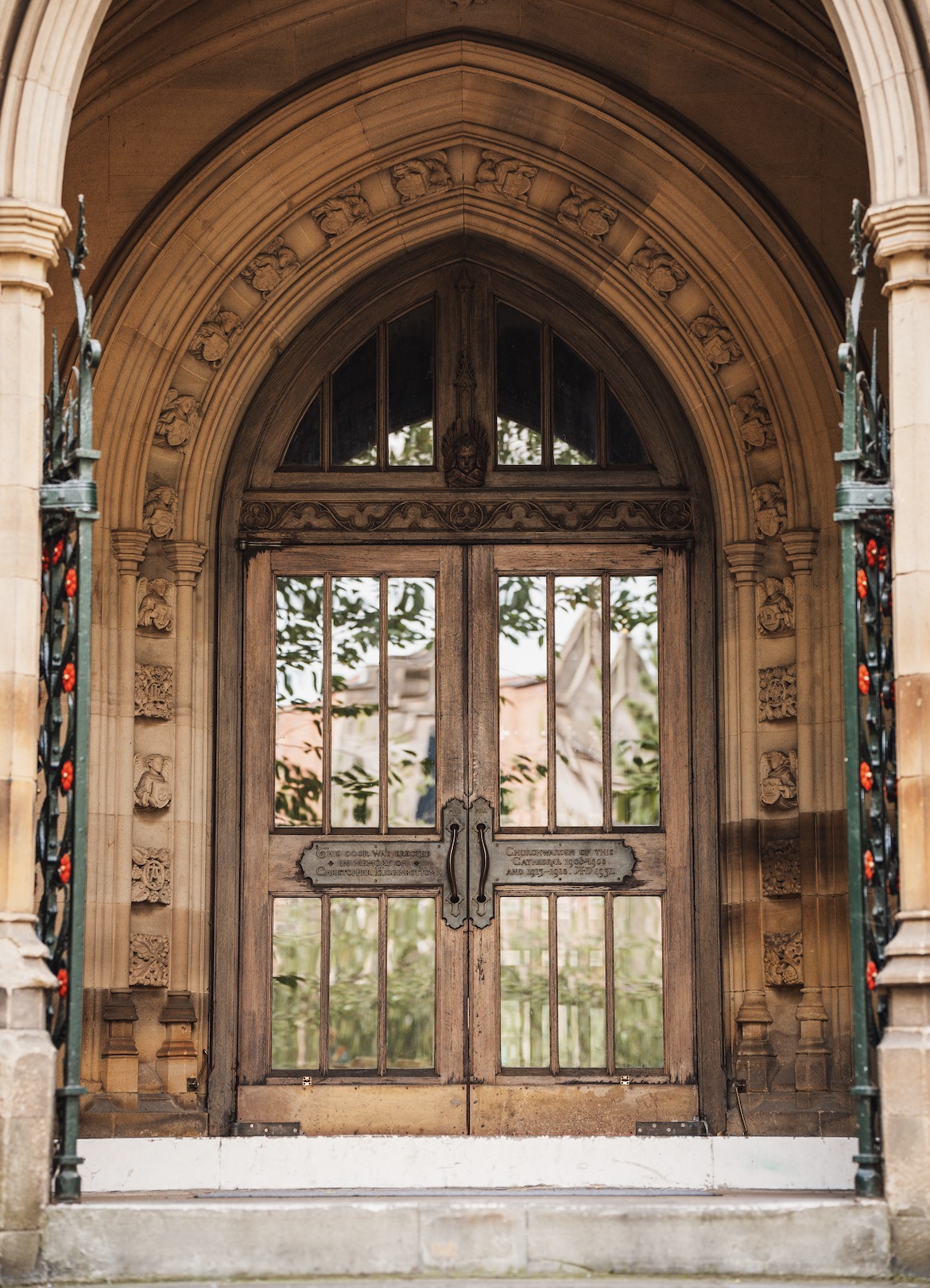
Newcastle Cathedral
These wooden doors are part of a memorial screen connected to the main west entrance of Newcastle Cathedral, dedicated to First World War combatants, including members of the Northern Cyclist Battalion. Positioned above these doors are depictions of various saints, including St George, St Michael, and St Nicholas, the patron saint of the Cathedral and historic inspiration for Santa Claus.
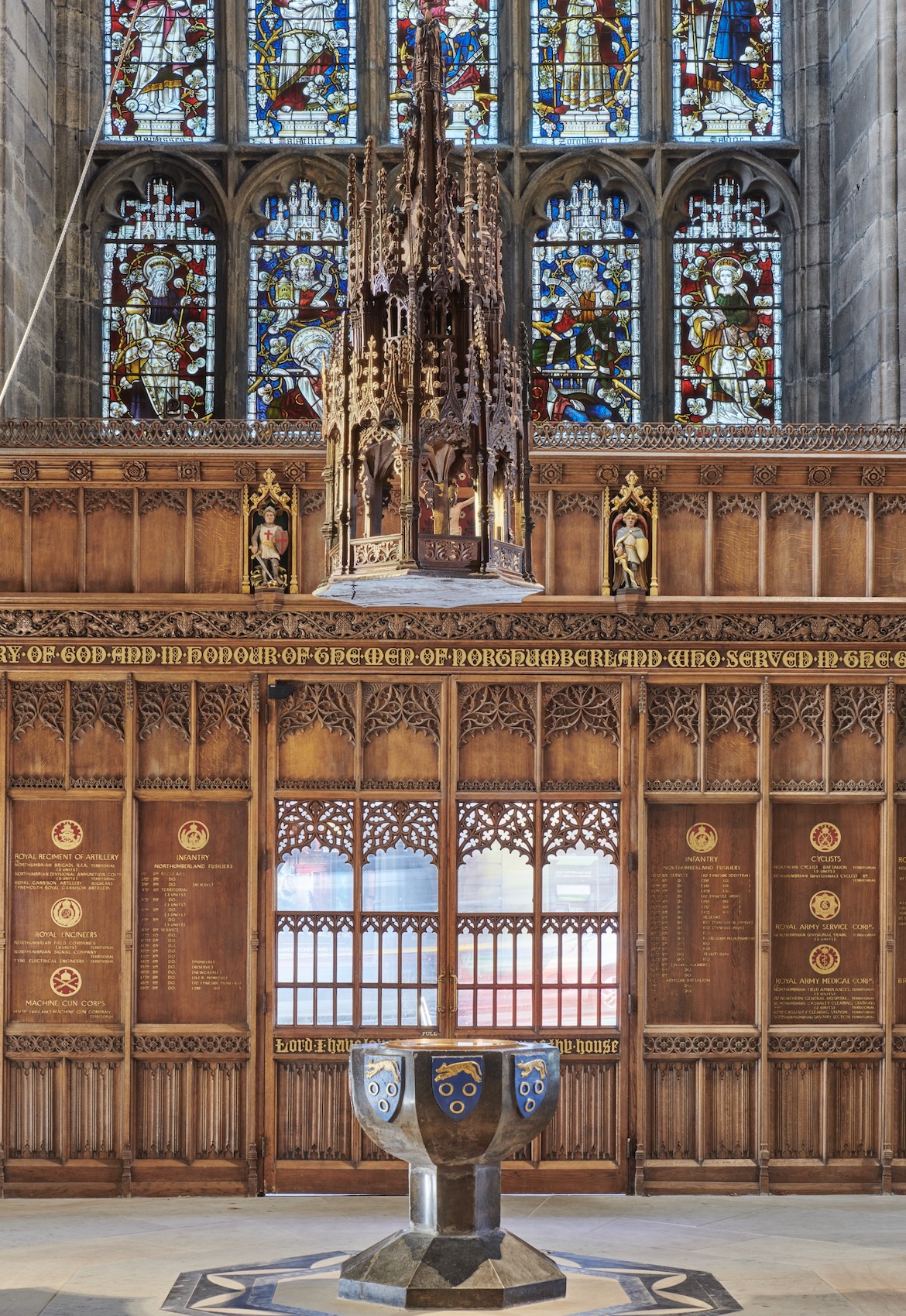
Norwich Cathedral
The Prior’s Door (ca. 1300) leads from the northeast corner of the Cloister into the South Aisle of the Nave and would have been the primary entrance into the Cathedral of the monastic community.
The elegant but vigorous figures show Christ in Judgement displaying the five wounds of his Passion and flanked by three pairs of figures: two angels bearing instruments of his Passion; to the left, St Peter wearing the papal tiara and pallium and holding the remnant of a key and the Church, and to the right St Edmund, King and Martyr, the chief saint of East Anglia; to the left, St John the Baptist wearing his camel’s-hair coat and to the right Moses, with horns and carrying the Tables of the Law.
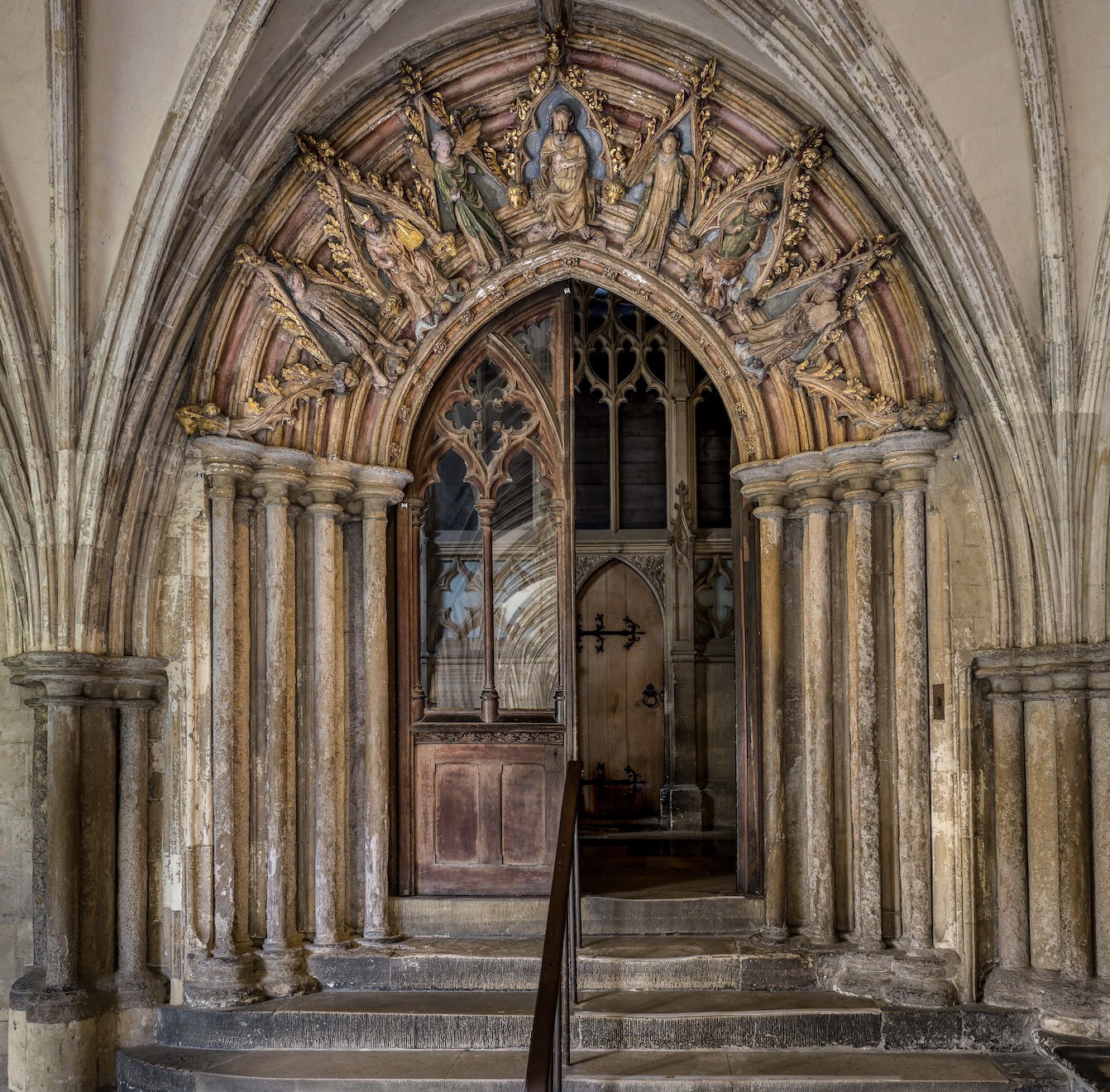
Portsmouth Cathedral
The West Doors of Portsmouth Cathedral were installed in 1997. Manufactured by the Sculpture Library, London, these doors are made of bronze and nearly weigh 2 tonnes. The design was created by Professor Bryan Kneale, the former Head of Sculpture at the Royal Academy, depicting the tree of life. They were gifted through donations, including from The News, a local paper.
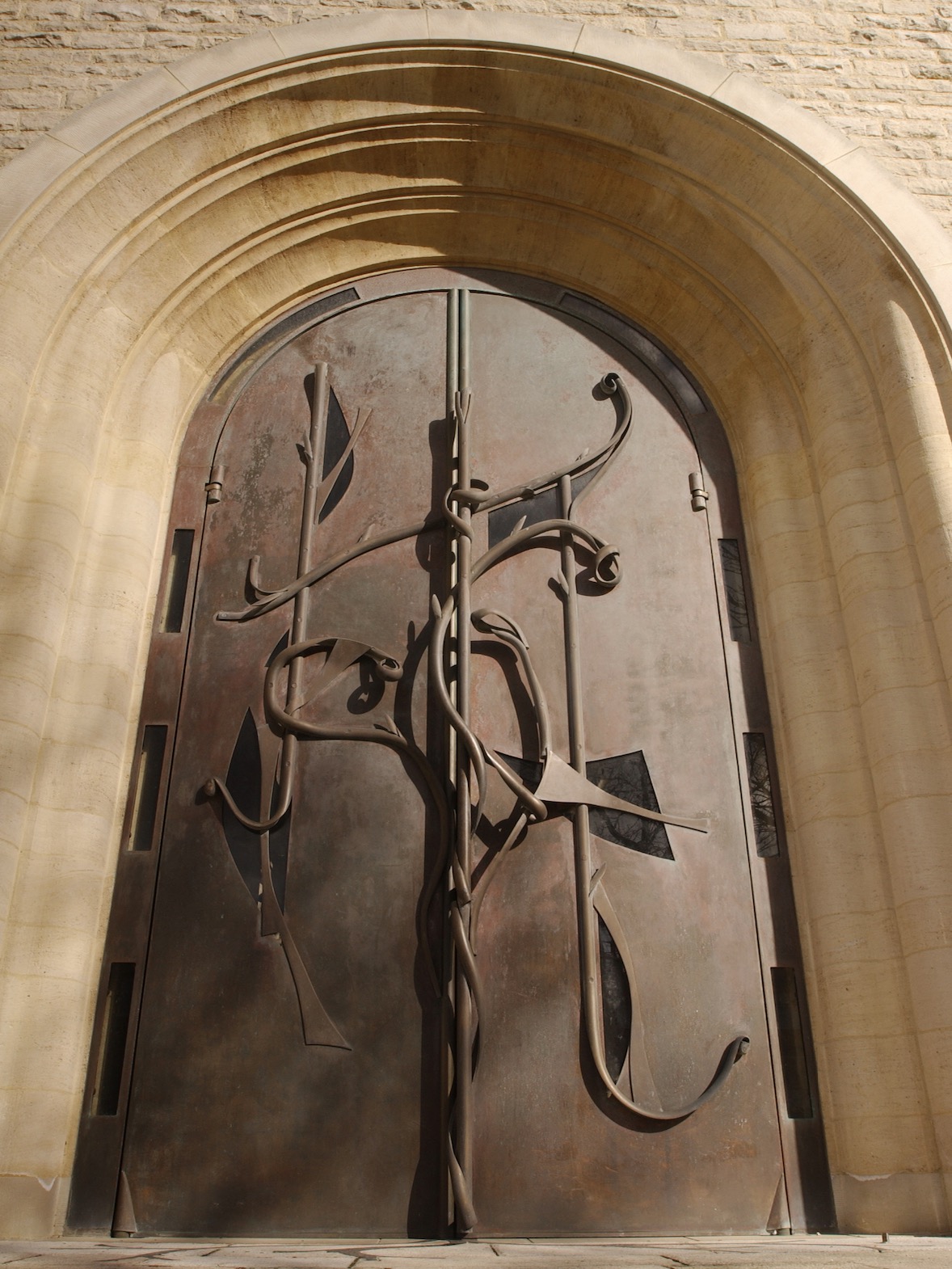
Ripon Cathedral
The heavy oak pulpitum doors to the quire at Ripon Cathedral have six painted wooden shields on them.Amongst the heraldry depicted on the shields are a mitre, representing Archbishop Thomas Rotherham, who was Archbishop of York from 1480-1500, and the estoiles (wavy stars) of the cathedral’s founding father Wilfrid who built his magnificent basilica here in 672.
It is imagined that Archbishop Rotherham helped with some of the restoration when part of the tower fell and when the nave was rebuilt (and also when the choir stalls and misericords were made).
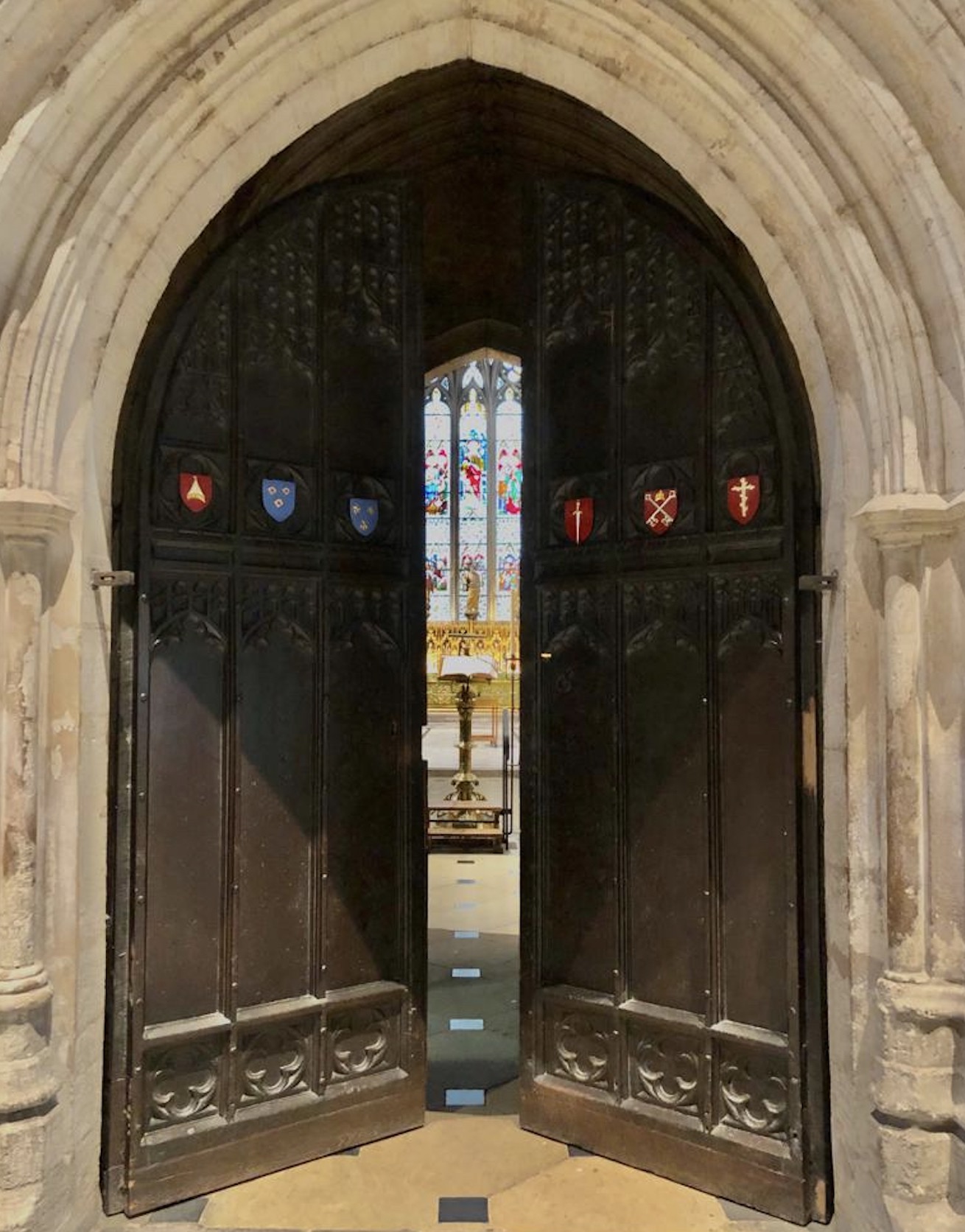
Rochester Cathedral
This is the Gundulf Door at Rochester Cathedral. It’s not on public view and is in the North Nave Quire Transept. It is believed to be the second oldest door in England. It dates back to 1080. It has been dated using dendrochronology which shows that the trees were felled between 1075 and 1108. The ironwork provides more evidence of the dating and it comes from the time when Bishop Gundulf rebuilt the Cathedral shortly after the Norman Conquest. It’s the only surviving piece of decorative iron and woodwork from this Cathedral.
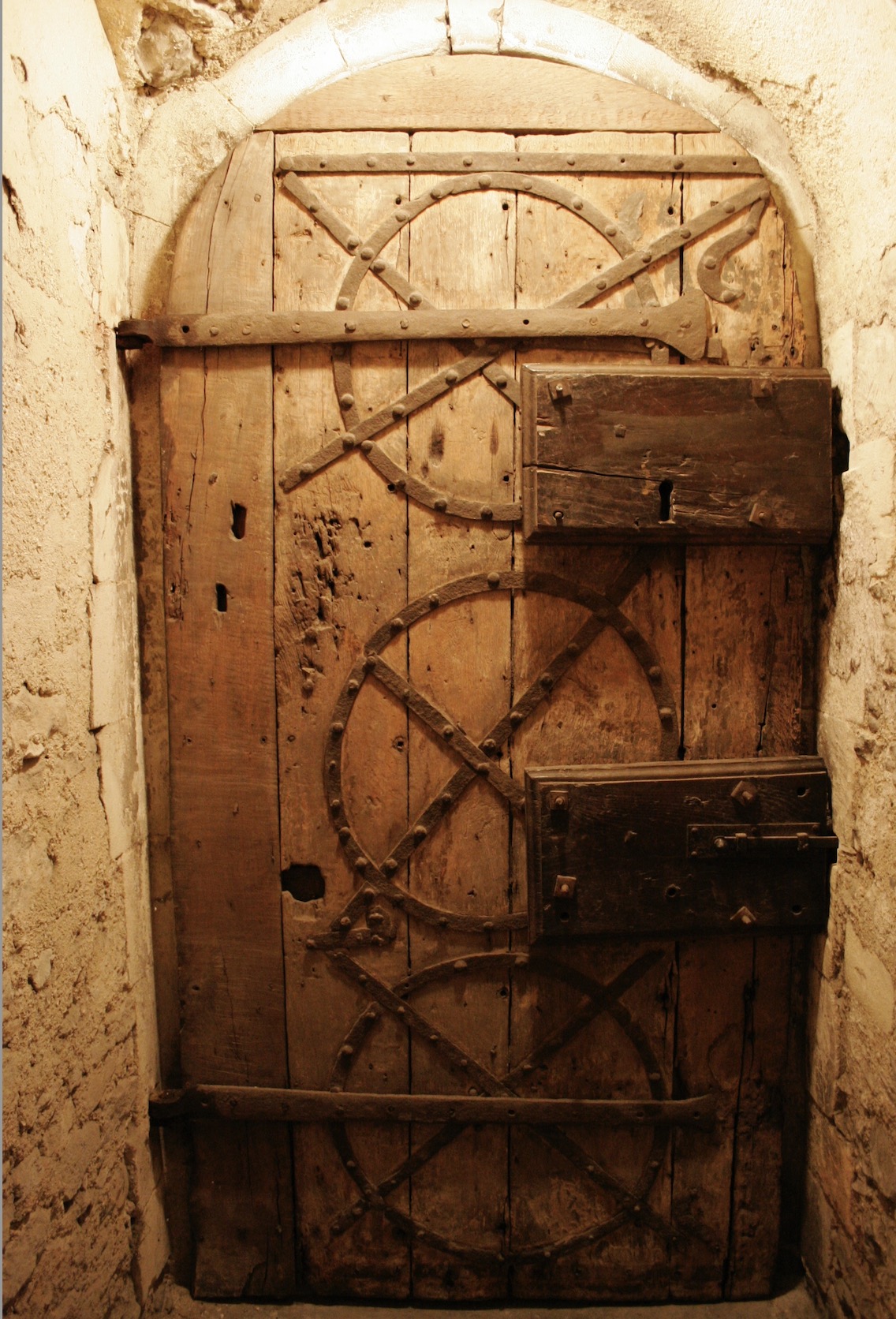
Salisbury Cathedral – the highest
The highest door in Salisbury Cathedral is 375 feet or 114m in the air, just a little under 9 metres below the top of the Spire. This is known as the weather door and is only used when essential maintenance needs doing – such as replacing the anemometer (used to measure the wind).
Here’s the door and the view from outside that only a lucky few will get to see.
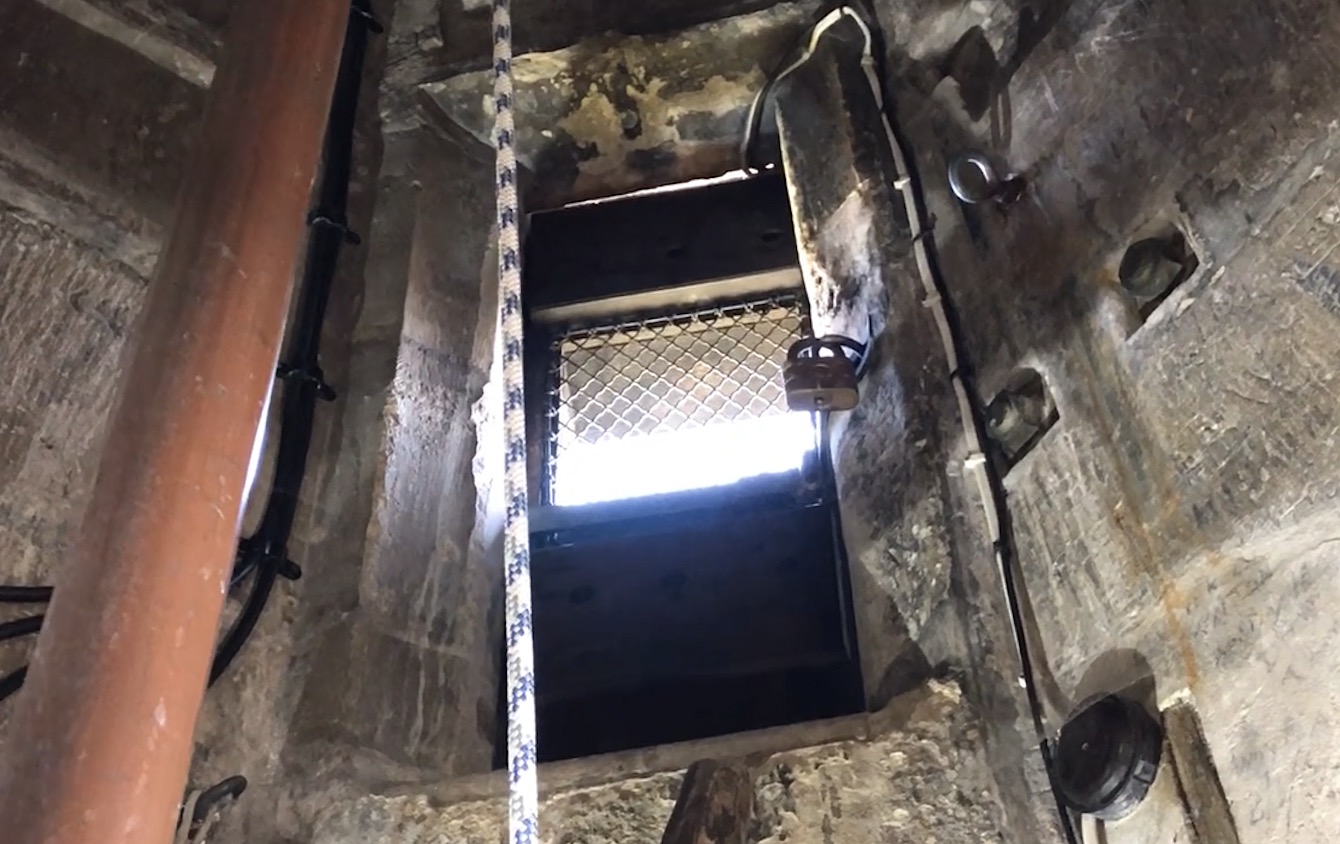

Sheffield Cathedral
To commemorate the gift to Sheffield Cathedral of the world’s first stainless steel door by G. Ethelbert Wolstenholme Secretary – Treasurer of the Sheffield Diocesan Trust & Board of Finance (1914 – 1940).
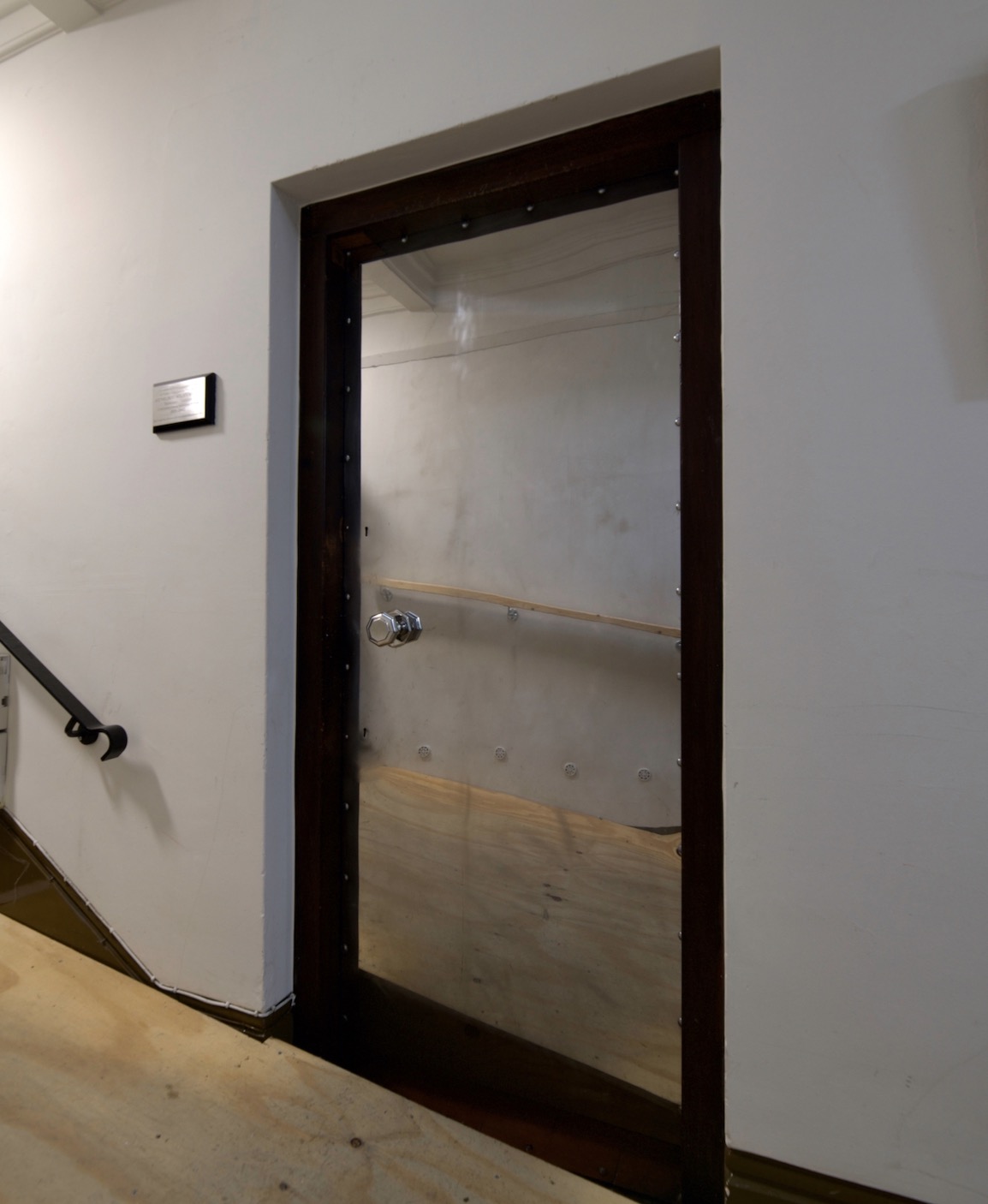
This plaque was presented by his children 15 January 1982.
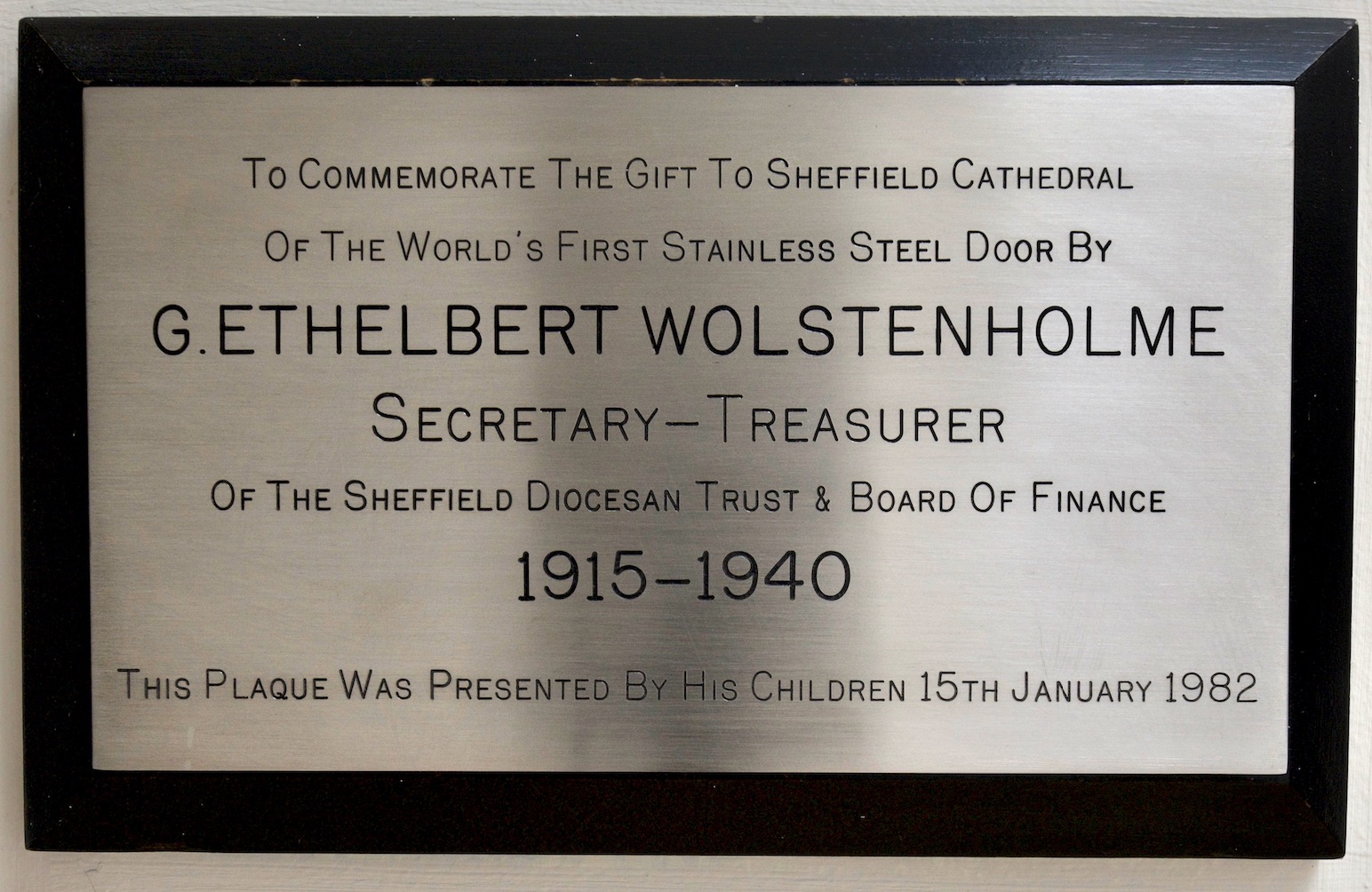
Southwark Cathedral
Southwark Cathedral stands at the oldest crossing point of the River Thames and has been a place of worship and welcome for over 1,000 years.
These doors sit on the south west of the Cathedral and are regularly used by visitors and worshippers alike to access the Churchyard and Herb Garden or to re-enter the Cathedral leaving the hustle and bustle of the surrounding area outside. Photo credit Roy Matlofsky.
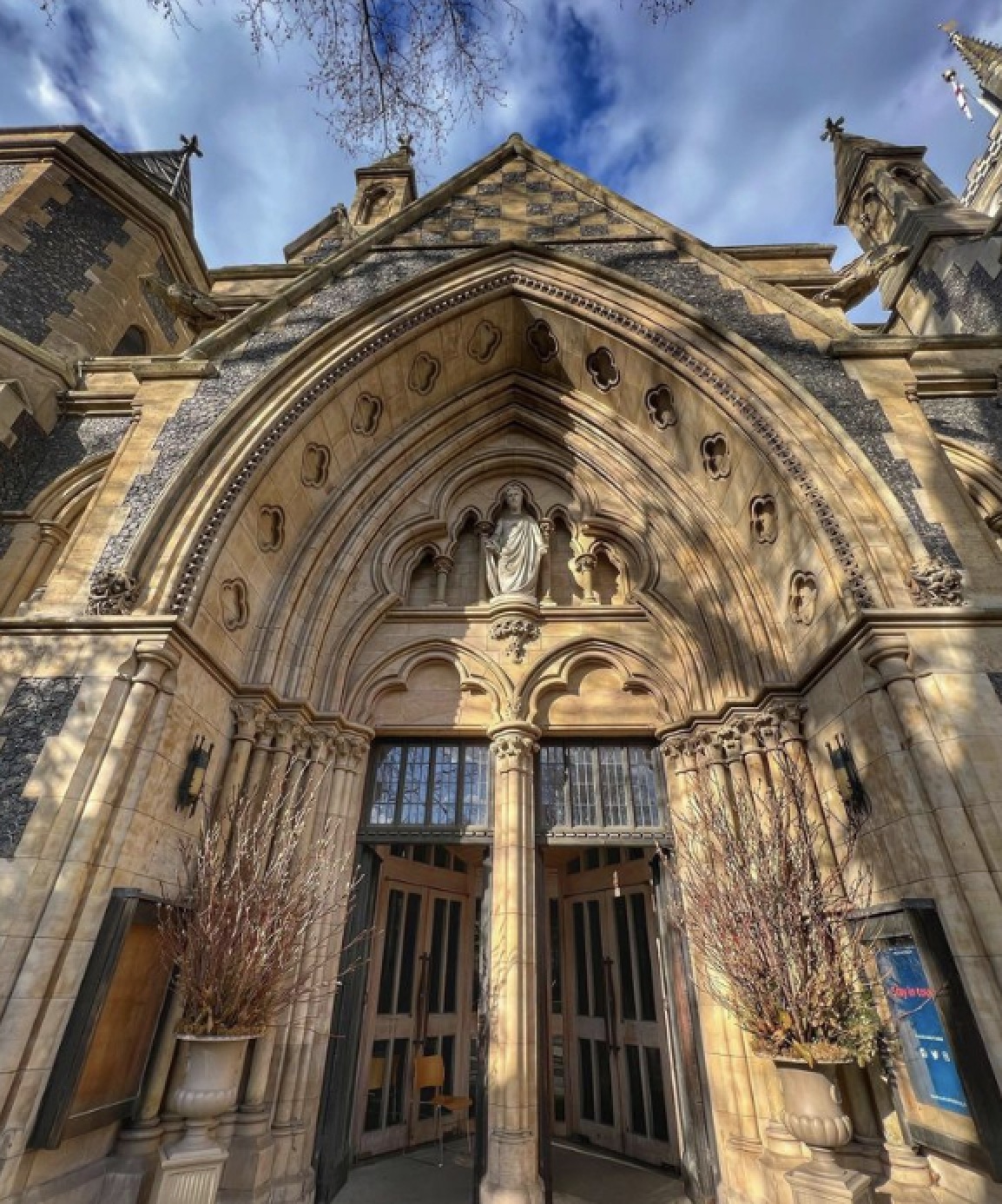
Southwell Minster
The magnificent original Norman Porch at Southwell Minster has a 14th century wooden door surrounded by seven different orders of limestone moulding including one of the extremely rare ‘beaks head’ decoration.
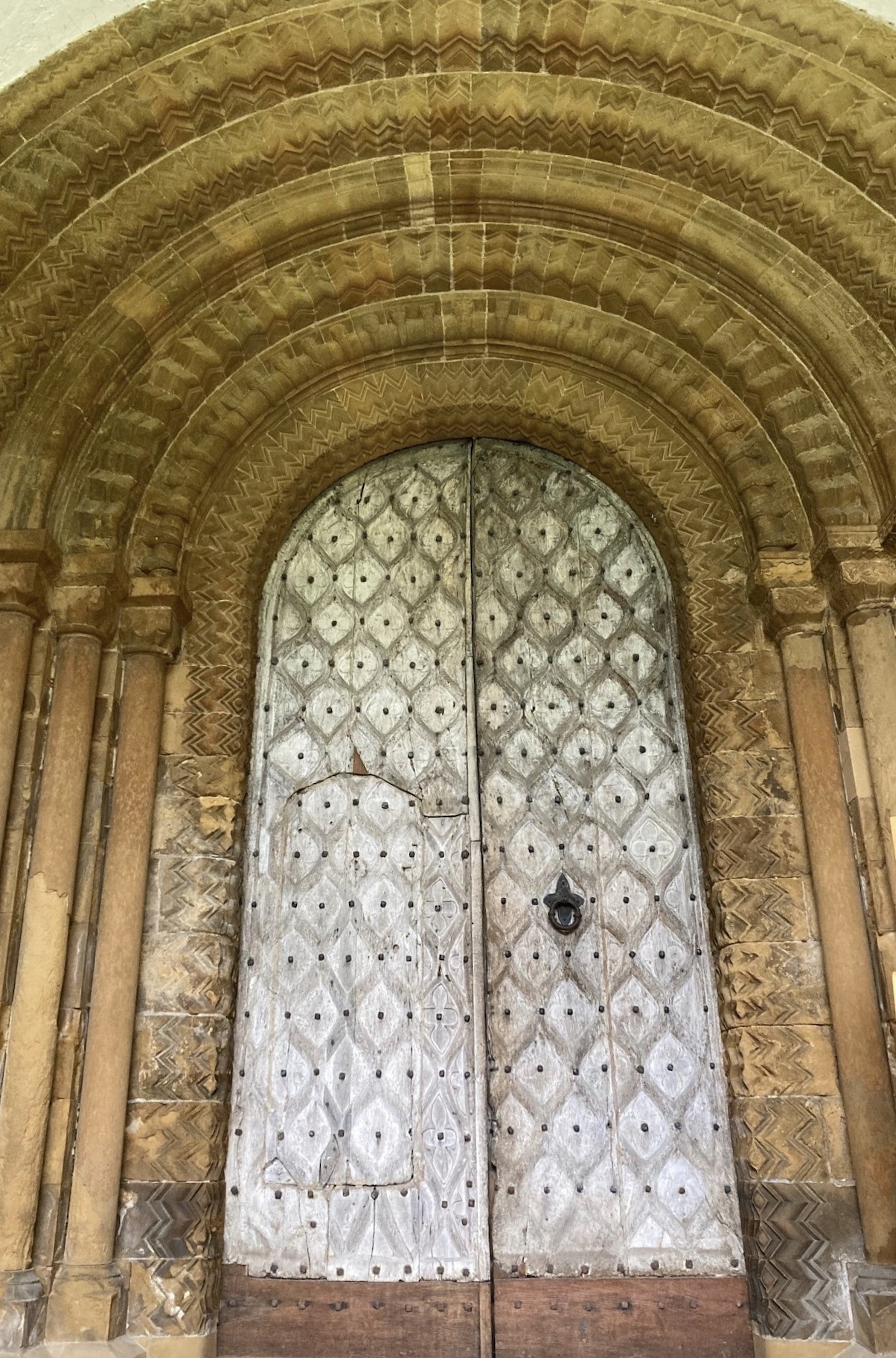
St Albans
The West Porch and Doorway to St Albans Cathedral: the west front of the cathedral was rebuilt by Edmund Beckett, Lord Grimthorpe, in 1880. He carefully preserved the old monastery doors, which can still be seen inside the building. Over a century later, in 1988, this grand and formal entranceway was completed with Sally Scott’s engraved glass of the Virgin and Child.
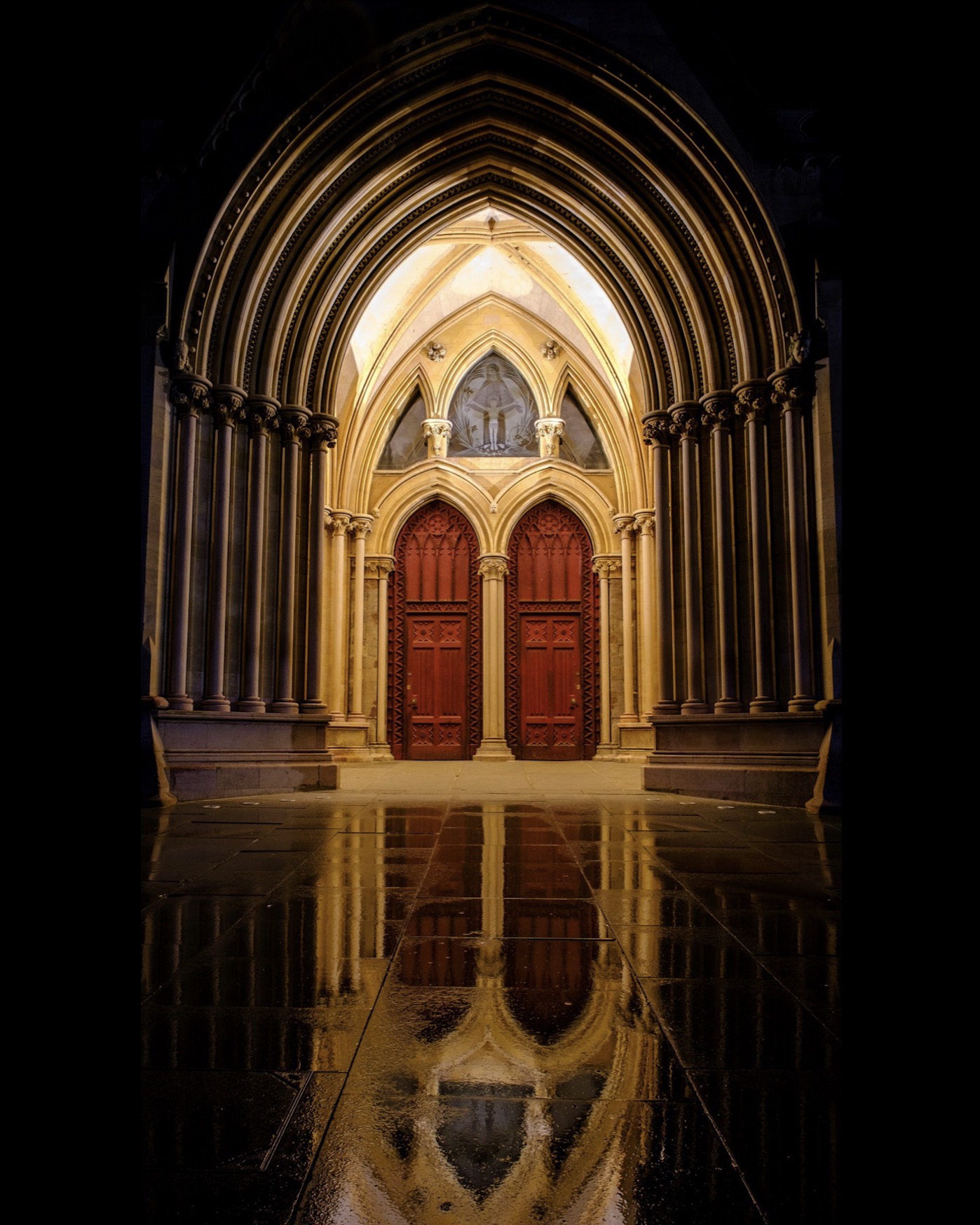
St Davids Cathedral
Here is a little-known door from St Davids Cathedral, our partner at the Church in Wales. It can be found on the North side of the substantial screen in the cathedral and opens the way to a tiny staircase leading to the top of the screen which gives way to an incredible view of the organ pipes packed into a tight space.
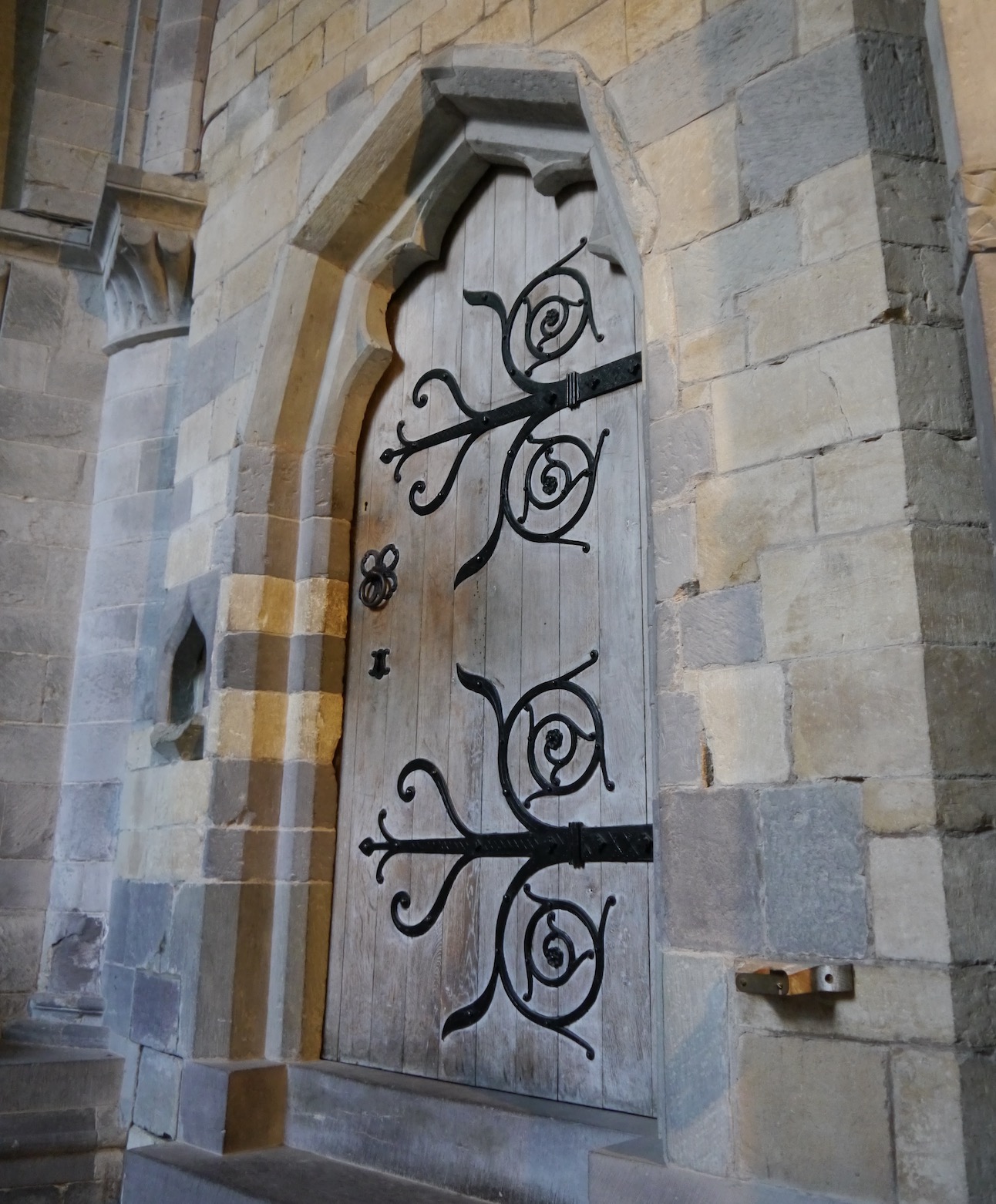
St Edmundsbury Cathedral
Hedgehog Highway.
St Edmundsbury Cathedral’s newest door is also it’s cutest door.
The hedgehog highway was installed in The Yard door this April and is designed especially for our prickly pals to reach our outdoor quiet space, safely. An official opening of the hedgehog highway took place on the same day as the official opening of The Yard.
The Yard is a social action project for young people in Bury St Edmunds and the surrounding area. The garden was originally an unused and overgrown area of the cathedral grounds that has been transformed to offer a safe space where young people can come and spend time, learn new skills, meet new friends and improve their mental health, wellbeing and resilience. Young people have taken part in every step of the project ensuring that it’s a space designed by them, for them.
Users of The Yard have welcomed sharing their area with hedgehogs. They’ve built a cozy hedgehog house and are hoping it gets discovered this autumn, in time for hibernation. Our environmentally friendly garden is full of slugs and worms for the hedgehogs to eat, and we never use slug pellets which can poison hedgehogs. We’ve also built a hedgehog-friendly habitat pile in case he would prefer to build his own house!
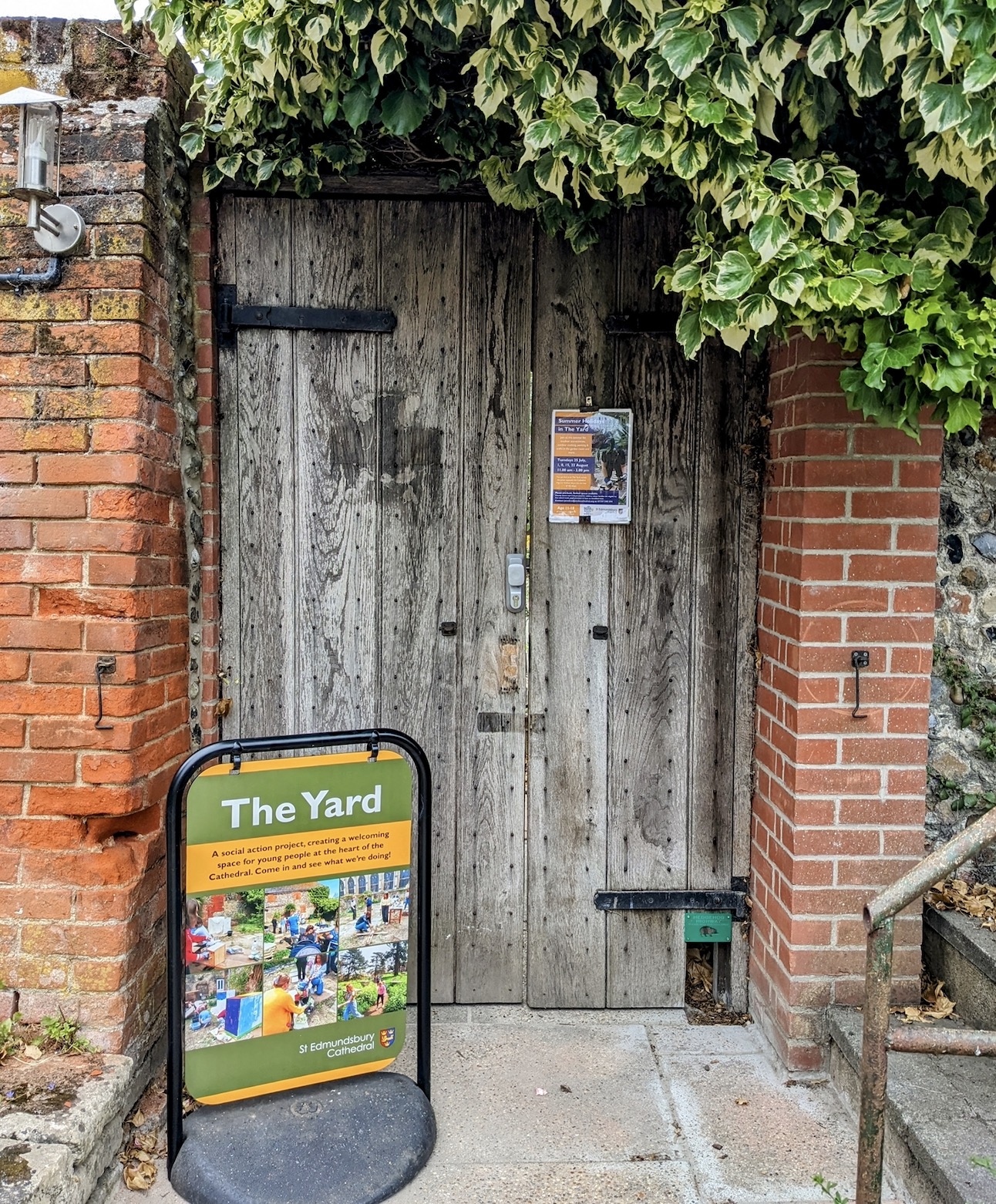
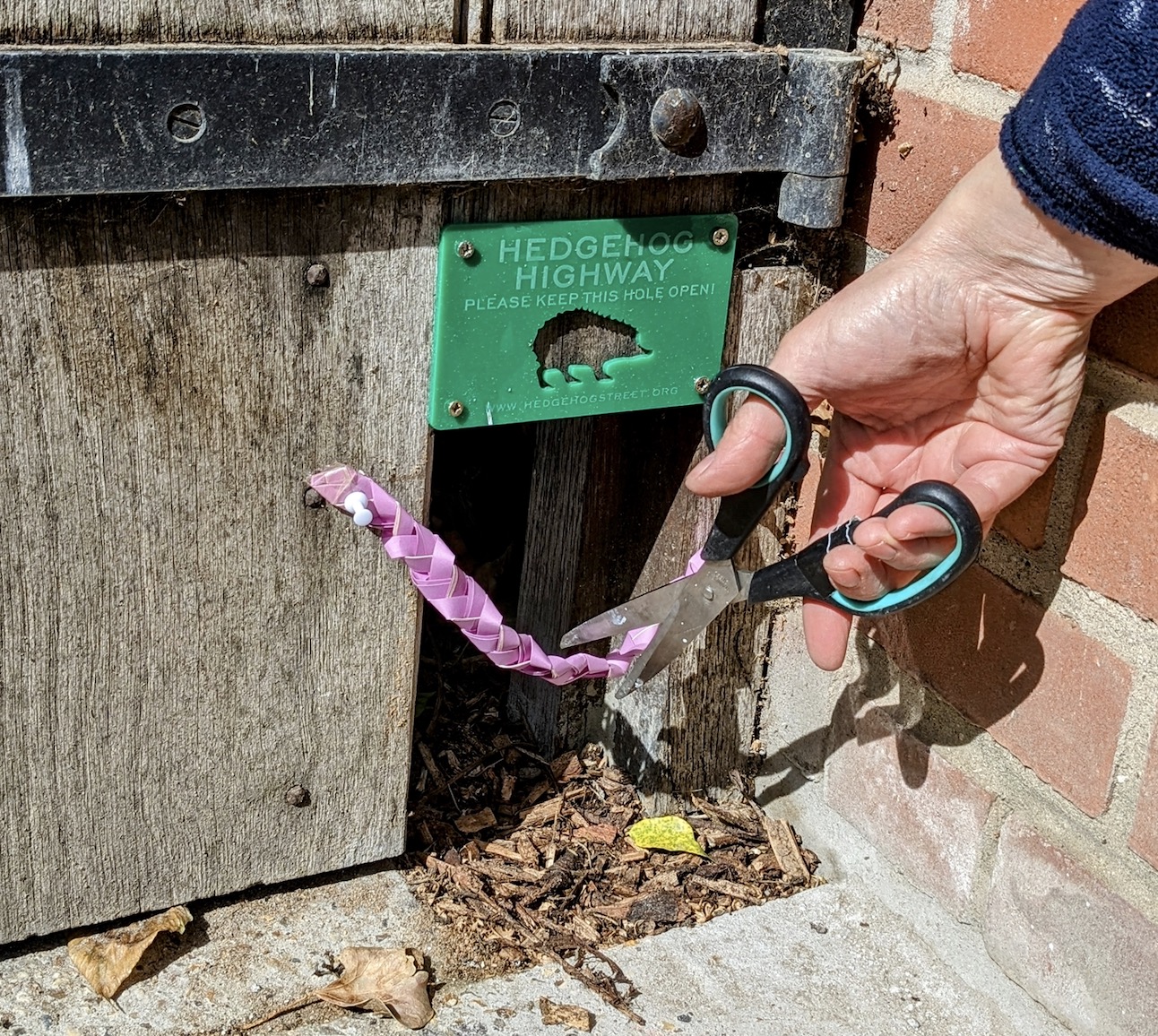
St Paul’s Cathedral
Doors that aren’t really doors: This is a monument in the North Nave Aisle of St Paul’s to William Lamb, Viscount Melbourne (1779-1848 and Prime Minister in 1834 and from 1835 to 1841) and his brother Frederick Lamb, Viscount Melbourne (1782-1853) by Carlo Marochetti RA, 1853. Metaphorical ‘doors to eternity’, they’re not really doors at all – they just appear to be! These are the Doors to Eternity.
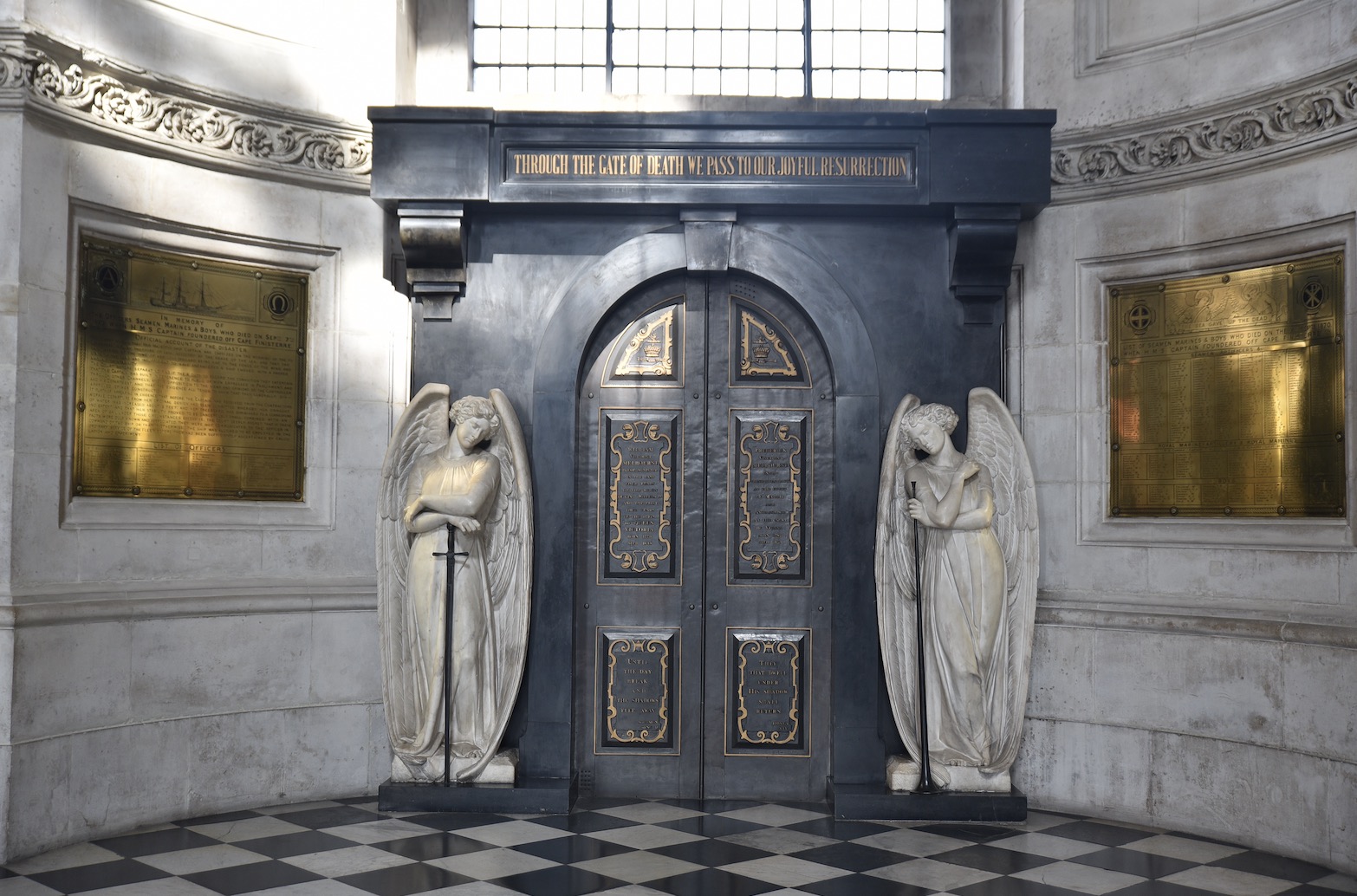
Wells Cathedral
Undercroft Doors. In medieval times, this entrance was the only way to the Undercroft since it was constructed to be a treasury housing the Cathedral’s treasures and valuable manuscripts.
Oxford Dendrochronology Laboratory gave the inner door a tree-felling date of c.1265.
The inner door opens inwards and consists of vertical planks strengthened by a ‘portcullis’ frame.
The intricate iron scrollwork with clusters of leaves, flowers and small birds—does not readily fit the wood, and may be recycled.
Above the door is a bolt hole, through which a huge bar could be dropped over the closed door at night.
The outer door is a few centuries younger (tree-felling date c.1450), fitted at a time when there were issues of security — there are several references to expenses on account of “the insurgents against peace of the church and the king”.
This door is even stronger by design, fitted with an impressive lock and bolting system, as well as vertical planks on one side and horizontal planks on the other.
Today, the outer door is kept permanently shut as the sacristy is on the side of it. Visitors can still admire the view of both via the Undercroft.
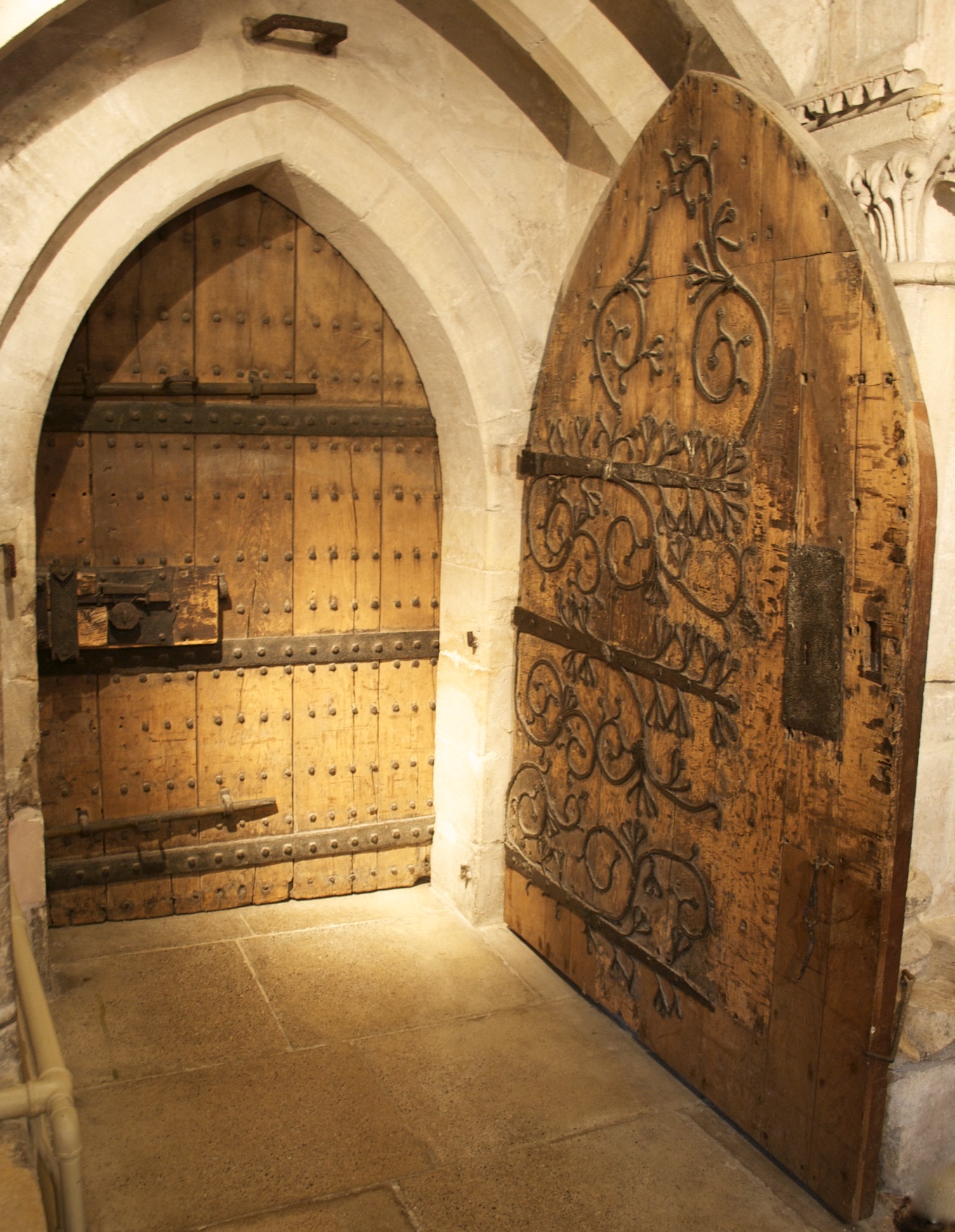
Westminster Abbey
Britain’s oldest door: The oldest door in Britain can be found in Westminster Abbey’s Chapter House. The wood for the door was cut down around 1032 AD, which was then built in the 1050s. This was during the reign of King Edward the Confessor who was responsible for building the Norman Abbey in the 11th century.
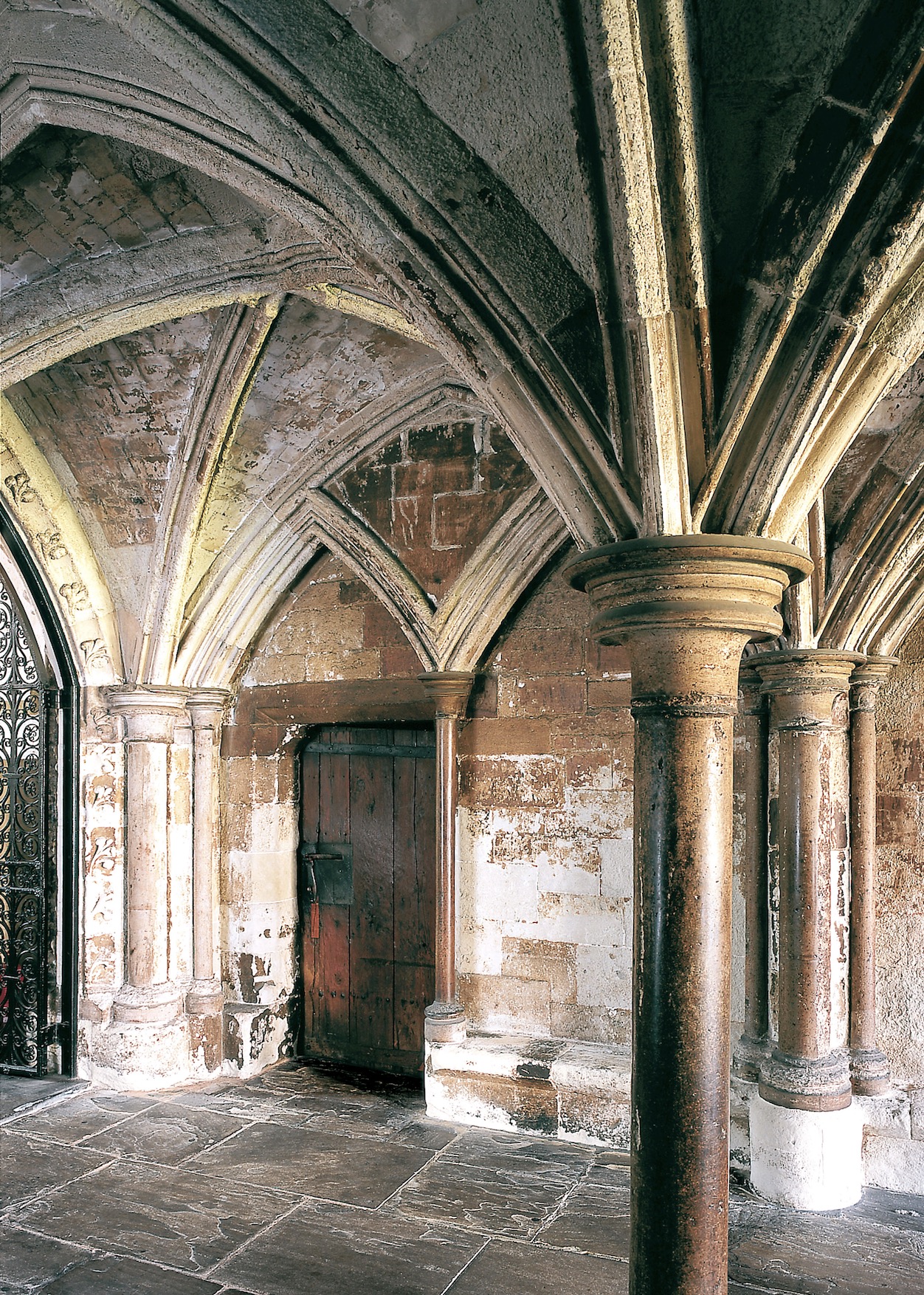
Winchester Cathedral
The West Doors. The west doors are studded with grids of iron nails and have bold twisted ring handles on decorative back-plates. The date of the doors and ironwork is not known, but it is possible that they are examples of Laudian Gothic from the time of Bishop Walter Curle (1632-1645).
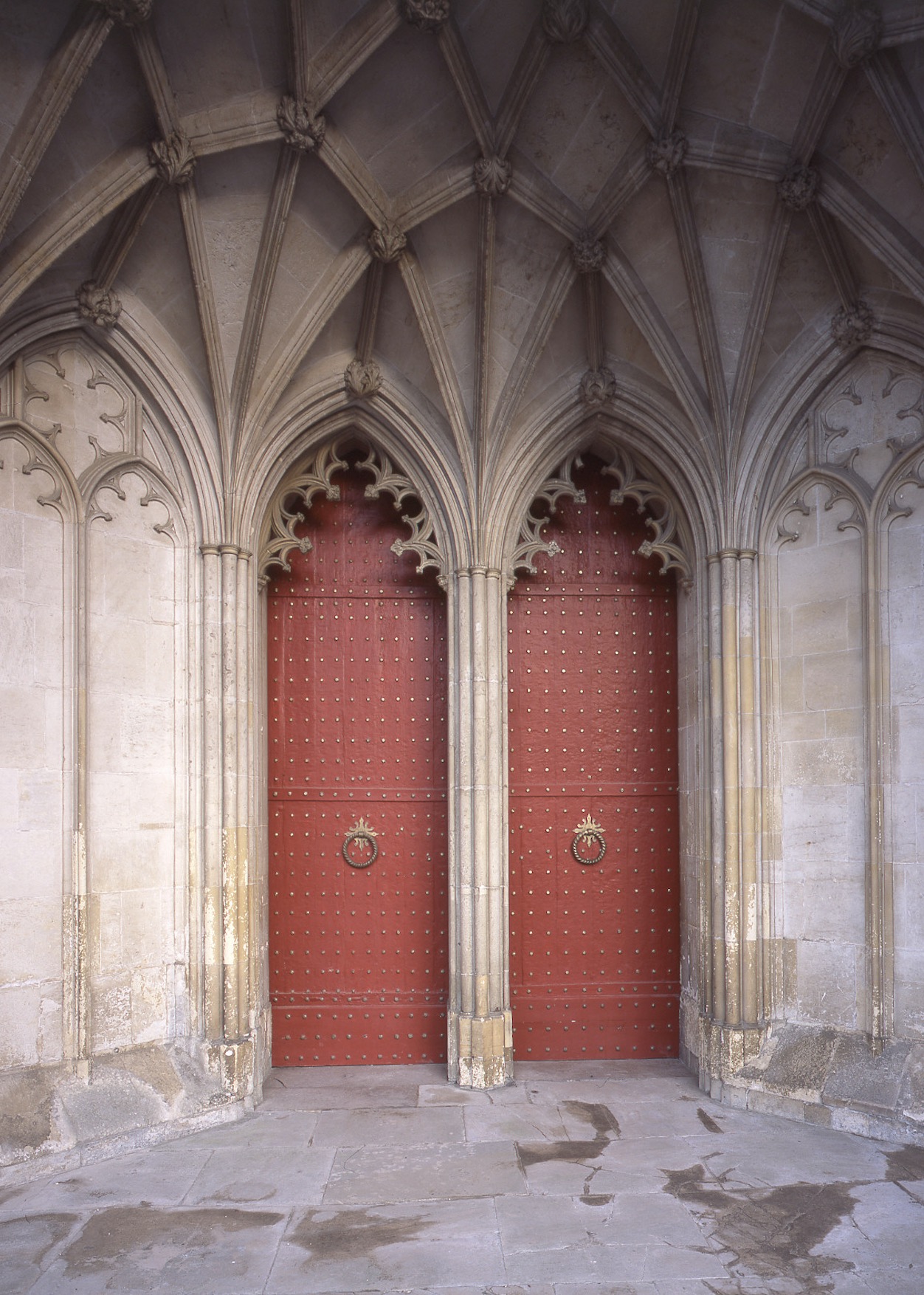
The Crypt Door.This door leads to Winchester Cathedral’s Crypt. The Crypt is the oldest part of the building (1079) and is a perfect example of the original Norman style of architecture with rounded arches and plain vaulting- the crypt door also leads to Antony Gormley’s ‘sculpture, Sound II’ which was designed to stand in water, and so, is ideally located in the Crypt.
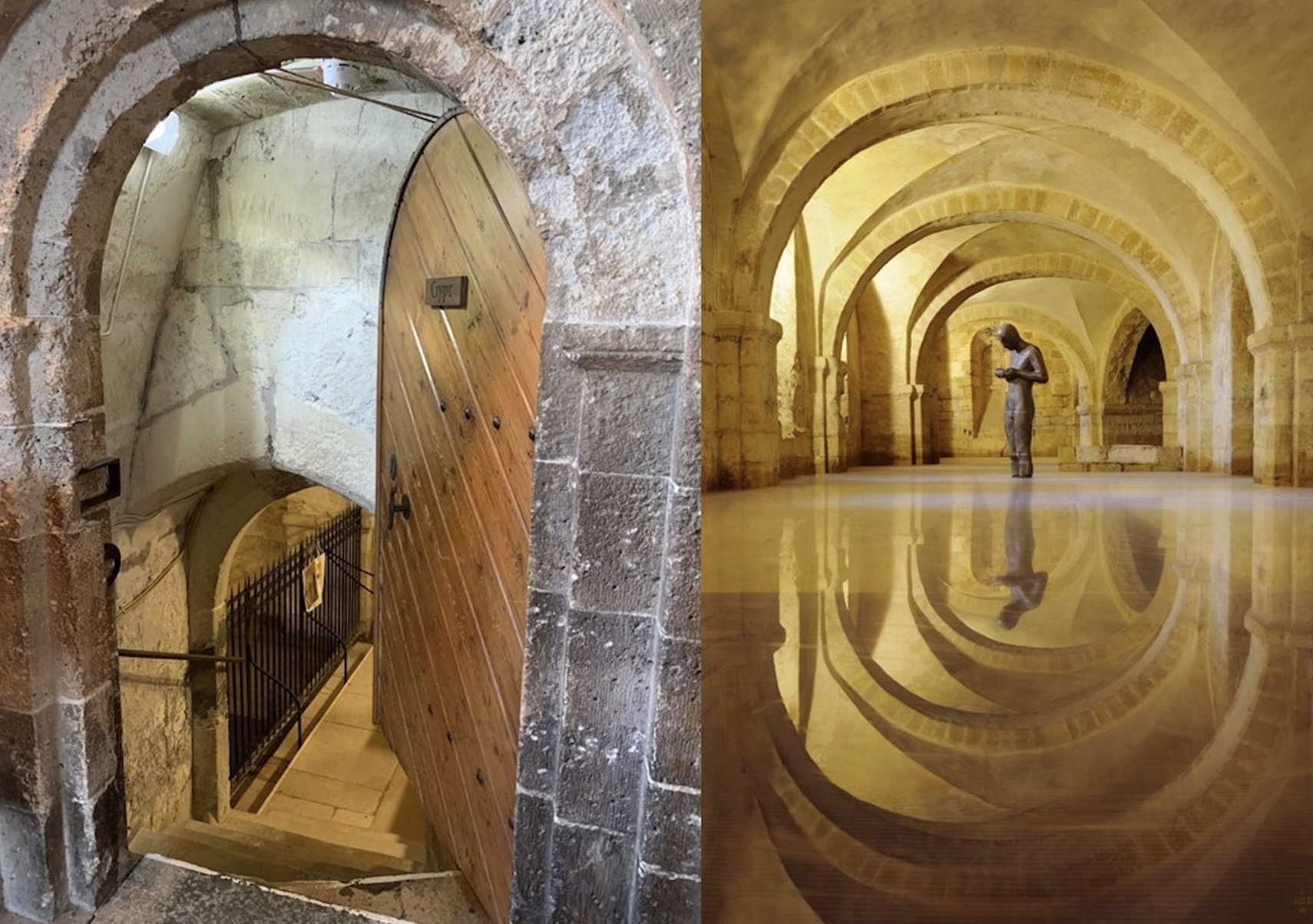
Worcester Cathedral
Viking Door. This is no longer in use as a door and has a rather macabre history! The story is that some Viking raiders came up the River Severn and one of them stole the sacristy bell. The monks were furious at this sacrilege and killed him, nailing his skin to the door as a deterrent to others.
Our human history – national, international and personal – has its darker sides. None of us is completely without fault. Too often, when evil prevails, we stand by and we fail to do good. Too often, we fail to act for justice and peace.
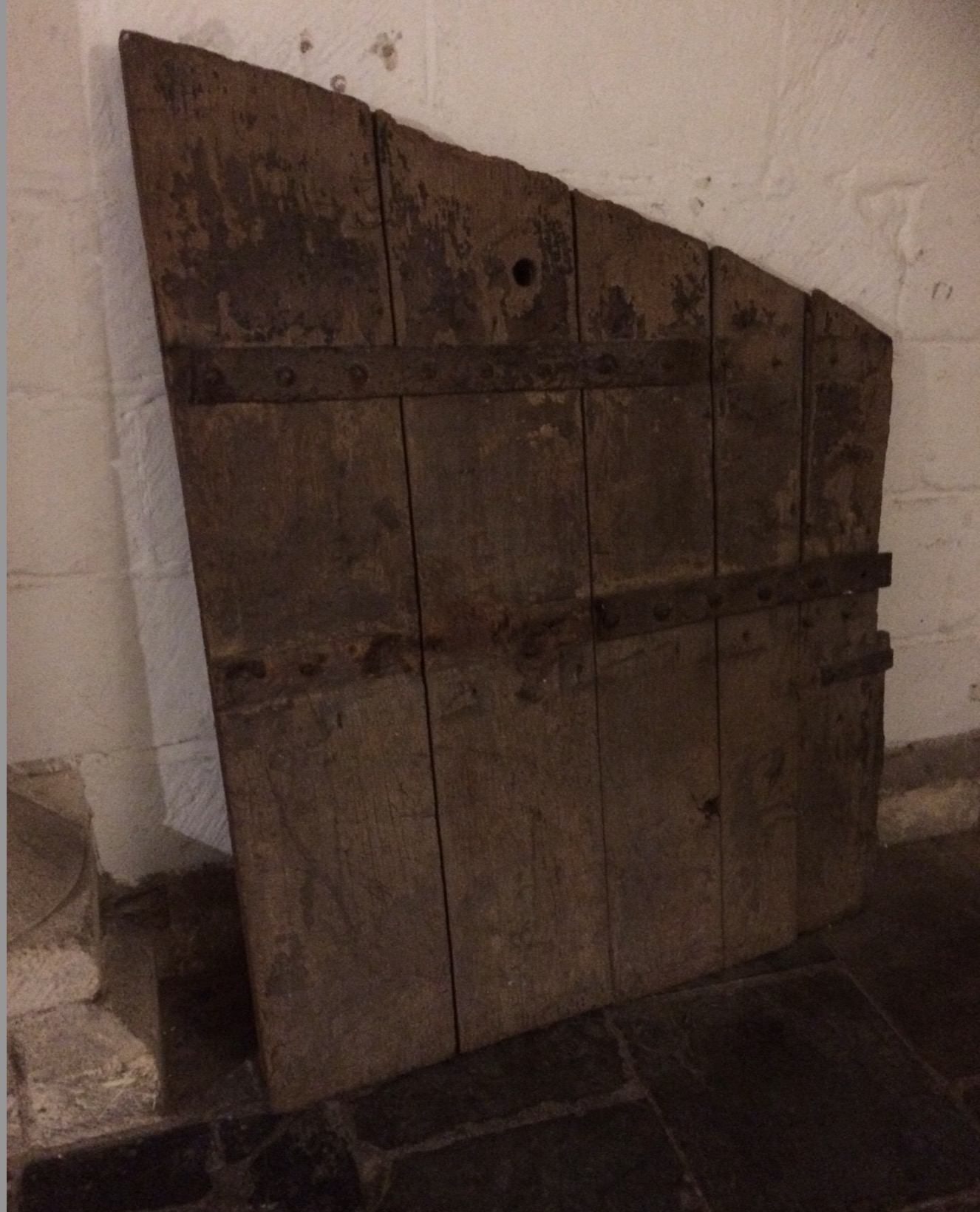
York Minster
The great west door is the ceremonial entrance to York Minster, where worshippers have been welcomed for centuries. Above the door is a beautiful stained glass window commissioned in 1339, more commonly known as the Heart of Yorkshire.
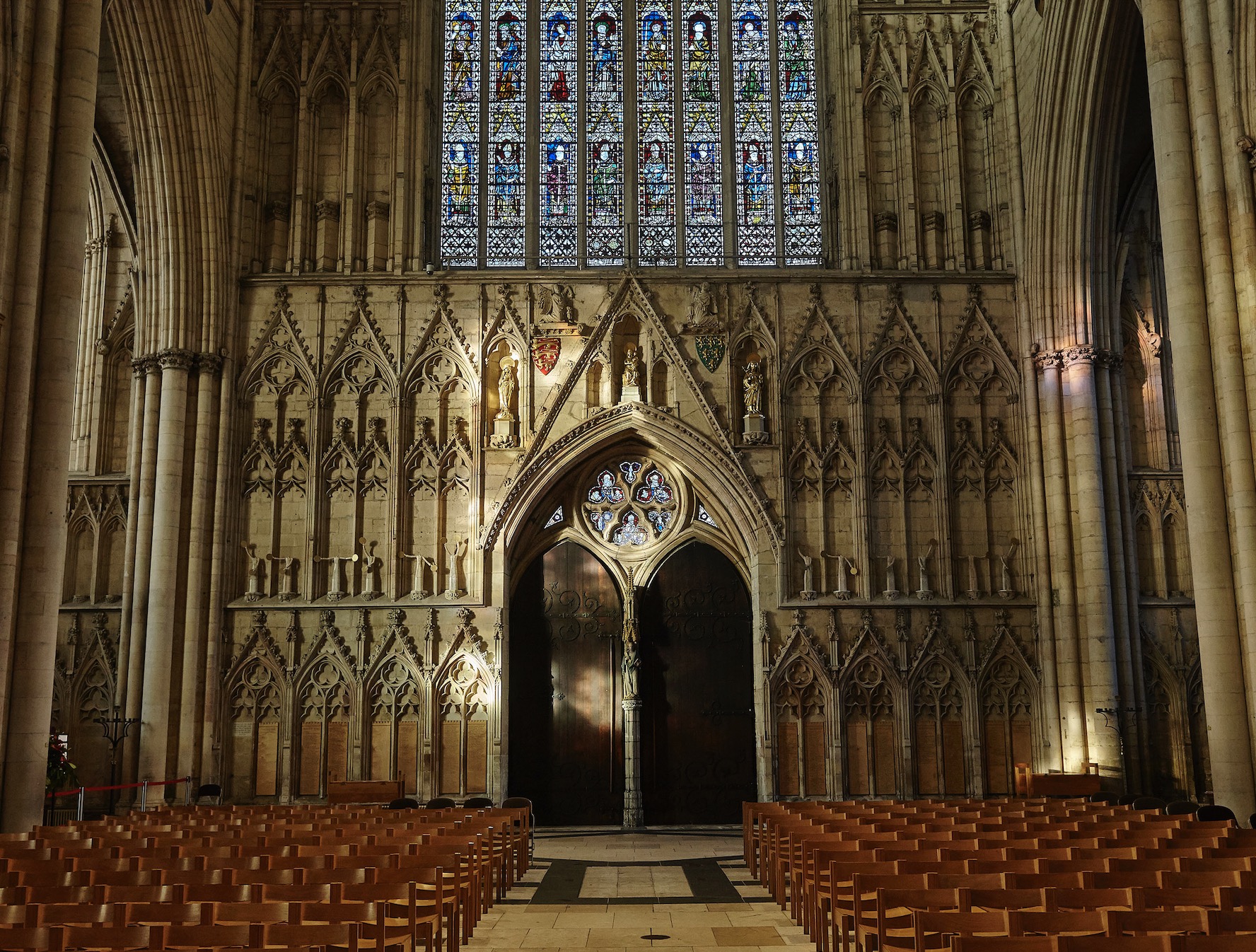
For information about all of our Cathedrals – click here.